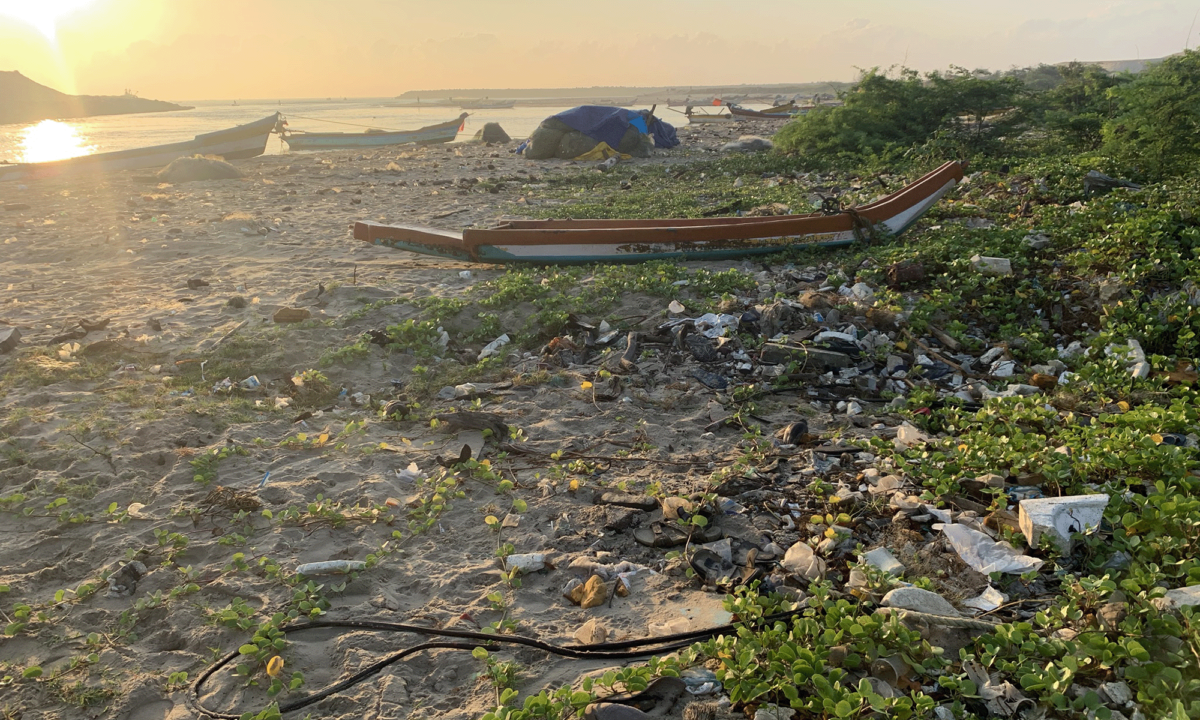Page Topics: Overview, The Life of Plastics, Plastic in the Ocean, Microplastics, Plastic Bags, Recycling & Solutions, Resources & References
Credit: Warren D. Allmon for the Earth@Home project.
Image above: Discarded plastics pollute the coastline of Tamil Nadu, India. Photograph by Warren Allmon.
Page last updated April 30, 2024.
Update! A meeting of the United Nations Environment Programme's (UNEP's) Intergovernmental Negotiating Committee took place April 23-29, 2024 in Ottawa, Canada. Tasked with developing an international agreement on plastic pollution (including in the oceans), you can read more about the outcomes of the meeting on the UNEP website, or in these two articles by The Canadian Press and The Guardian.
Overview
“Plastic” refers to a wide range of synthetic (human-made) materials composed mainly of substances called polymers (chemicals consisting of very large molecules composed of repeating subunits). Most modern plastic polymers are derived from chemicals made from petroleum (petrochemicals), but a small amount is made from materials derived from plants, including cellulose or starch.
The first synthetic plastic – Bakelite – was produced in 1907, marking the beginning of the global plastics industry, but rapid growth in plastic production didn’t happen until the 1950s. Since then, annual production of plastic has increased enormously.
Global plastics production, in millions of tons, since 1950. Graph from Our World in Data (Creative Commons Attribution 4.0 International license)
Plastic is useful for many reasons, and plays a crucial role in modern life in literally countless ways. Essential activities such as manufacturing, communications, medicine, and especially the food supply chain would be impossible in their present form without plastic. It has allowed many technological advances, such as vastly improved food and medicine storage, lighter weight vehicles, and a multitude of consumer, industrial, and commercial uses – from pens, signs, and medical equipment to clothing, car, and spacecraft.
But plastic – in its production, use, and disposal – also produces huge and growing problems for the entire Earth. Addressing this situation is an enormous challenge, equal in magnitude in many ways to climate change. It will not be easy to solve and will inevitably involve difficult tradeoffs.
The "good news" is that people, organizations, and governments around the world are increasingly recognizing this as an urgent environmental problem. Research on the scope of and possible solutions to challenges posed by plastic production and disposal is increasing rapidly, and numerous initiatives are underway to address it.
"Wrapped in Plastic: Earth Day 2024 (In the Greenhouse #25)" by the Paleontological Research Institution (YouTube).
What's Wrong with Plastic?
Plastic lasts a long time. Unlike many materials that people throw away – such as cardboard, natural fiber, or even metal – plastic lasts a long time. Most plastics do not break down (degrade) quickly when they are discarded, and that means they persist in the environment, causing long-term problems for living systems. (Plastics that break down due to the action of bacteria are called biodegradable. They cause fewer environmental problems, but extremely little of today's mass-produced plastic is biodegradable.) The combination of plastic's harmfulness and persistence means that its continuing production, use, and disposal are leading to what one recent study has called the "near-permanent contamination of the natural environment".
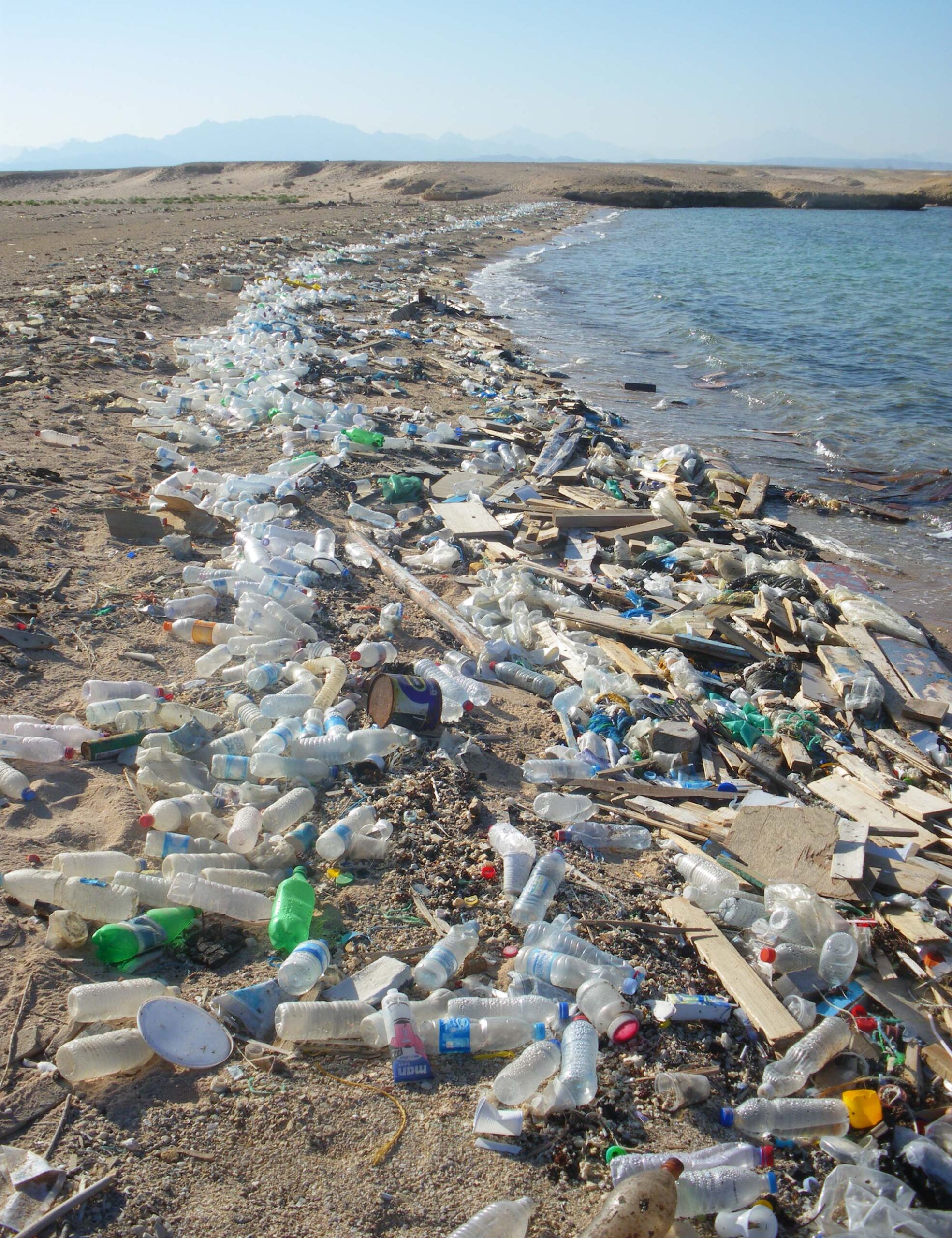
Plastic waste washed ashore on the coast of the Red Sea in Sharm el-Naga, Egypt. Photo by "Vberger" (Wikimedia Commons; public domain).
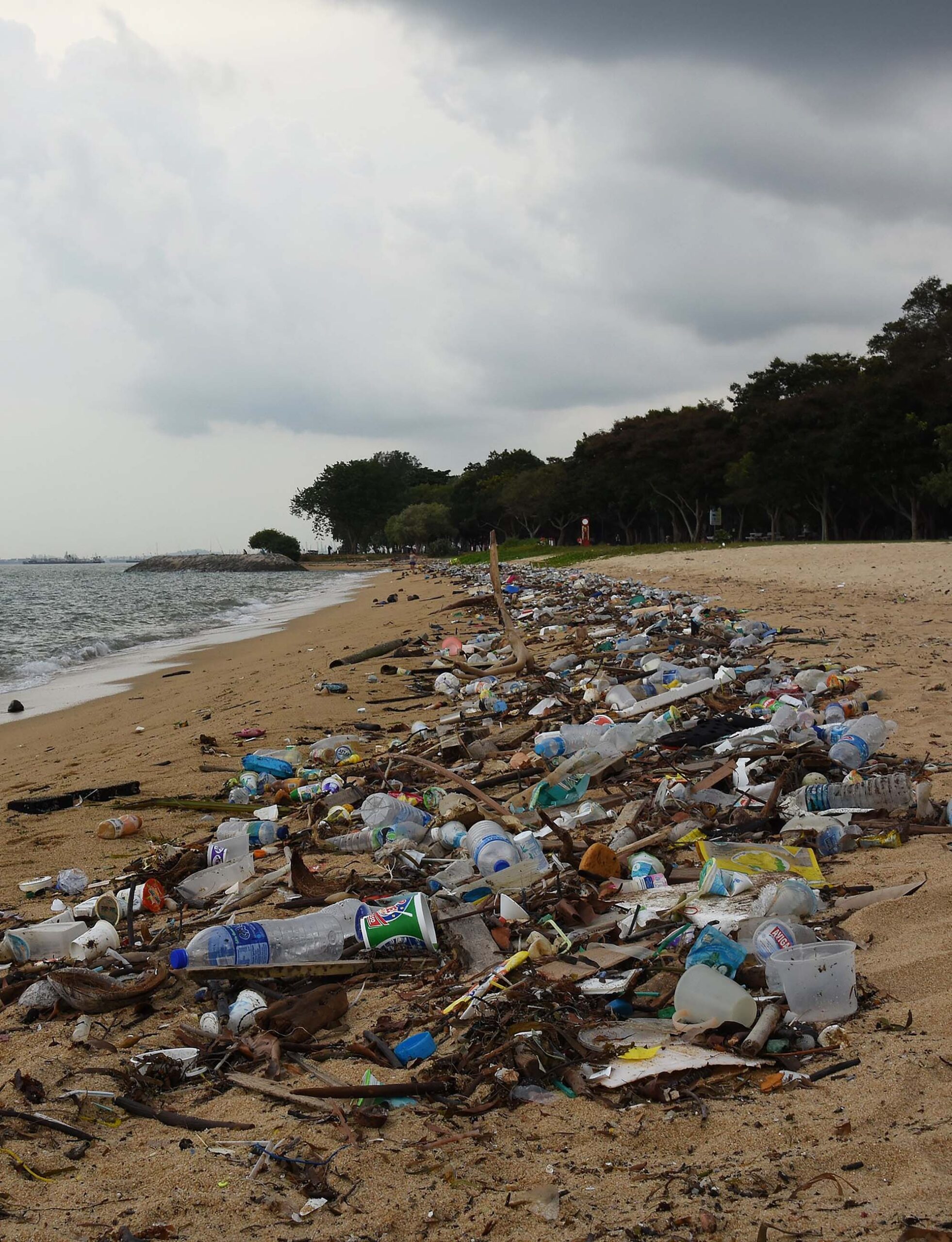
Plastic waste washed ashore on a beach in eastern Singapore. Photo by "vaidehi shah" (Wikimedia Commons; Creative Commons Attribution 2.0 Generic license).
Some plastic can be hazardous to our health. Although some plastics are relatively inert and thought to be safe for most uses (such as food packaging), other plastics can be chemically harmful to living things, including humans. Most modern mass-produced plastics are made from petrochemicals containing toxic compounds (or they contain toxic additives) which can cause a wide array of health problems, from cancer to immune disorders. The sheer volume of plastic being produced today means we are putting vast quantities of these compounds into the environment where we (and every other living thing) cannot help but encounter them.
In addition to its own toxicity, some plastics can carry other toxic substances long distances. For example, plastic debris in the ocean is associated with persistent organic pollutants (POPs), including polychlorinated biphenyls (PCBs), pesticides, and polycyclic aromatic hydrocarbons (PAHs), due to the affinity of these molecules for some kinds of plastic. When plastic is incinerated, many of the toxic chemicals in it are put into the atmosphere.
Plastic that is very durable (non-degradable) can also cause physical damage to living things. For example, plastic waste may look like food to many wild animals, but when they consume it, they cannot digest it. In general, plastic (whether it is chemically toxic or not) can cause many kinds of serious physical damage to animals, such as choking, drowning, starvation, amputation, and other trauma. This is a particular problem for plastic waste in the ocean.
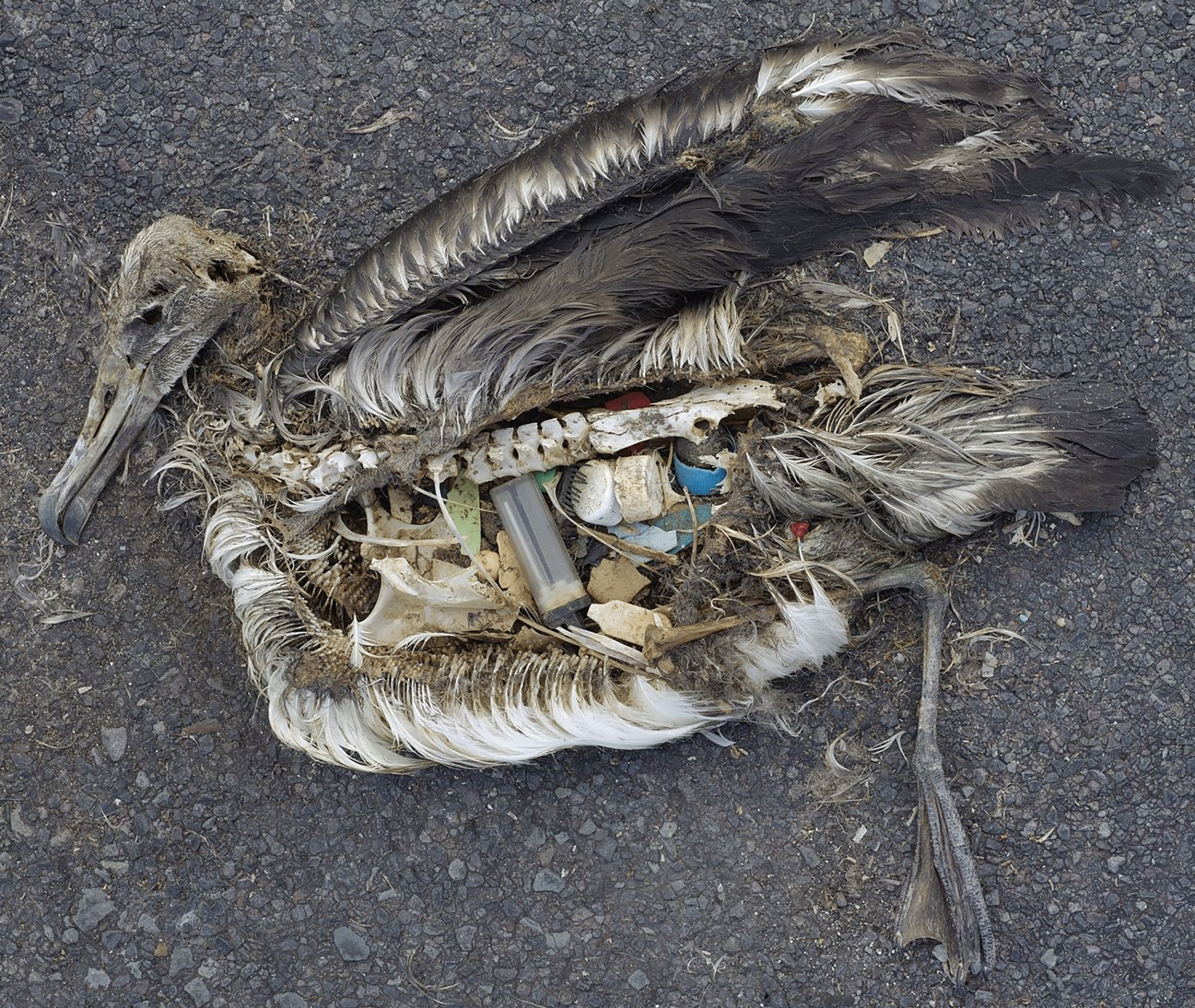
A dead albatross chick with abundant plastic pieces in its stomach. Photo by the U.S. Fish and Wildlife Service (Flickr; Creative Commons Attribution 2.0 Generic license).
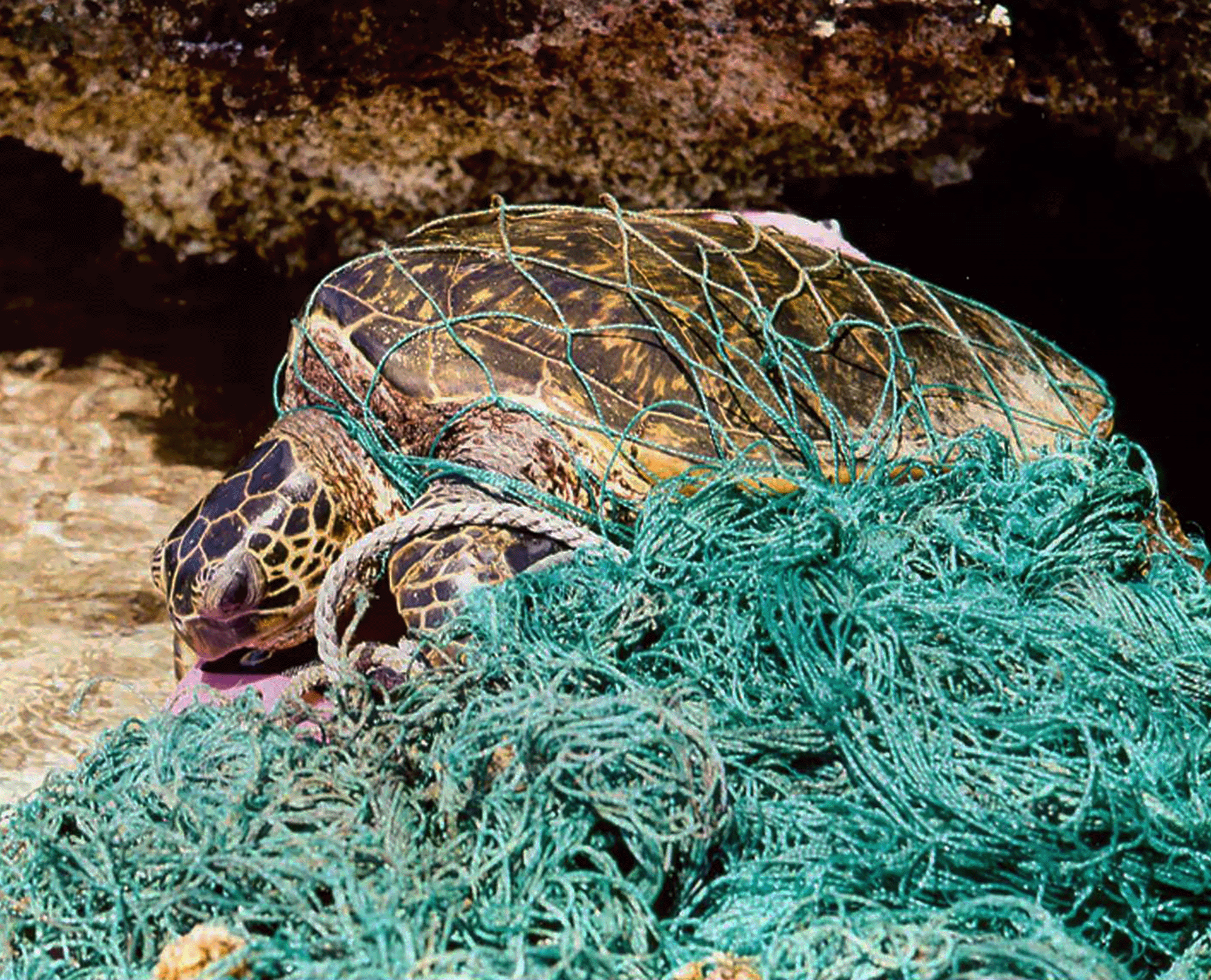
A green sea turtle entangled in a fishing net. Photo by the National Oceanic and Atmospheric Administration Marine Debris Program (Flickr; Creative Commons Attribution 2.0 Generic license).
Plastic contributes to climate change. Plastic contributes to climate change in several ways, mainly in the energy required to produce it. Most of the energy for making plastic comes from fossil fuels which release greenhouse gasses, and producing plastic from "virgin" (i.e., not recycled) materials generally takes more energy than doing so from recovered/recycled materials. Disposing of plastic by burning it also produces greenhouse gasses.
The Life of Plastics
Plastic has a "life cycle"; it is produced, used, and discarded. The effects of plastic on Earth's life and environments depends on what happens during each of these phases.
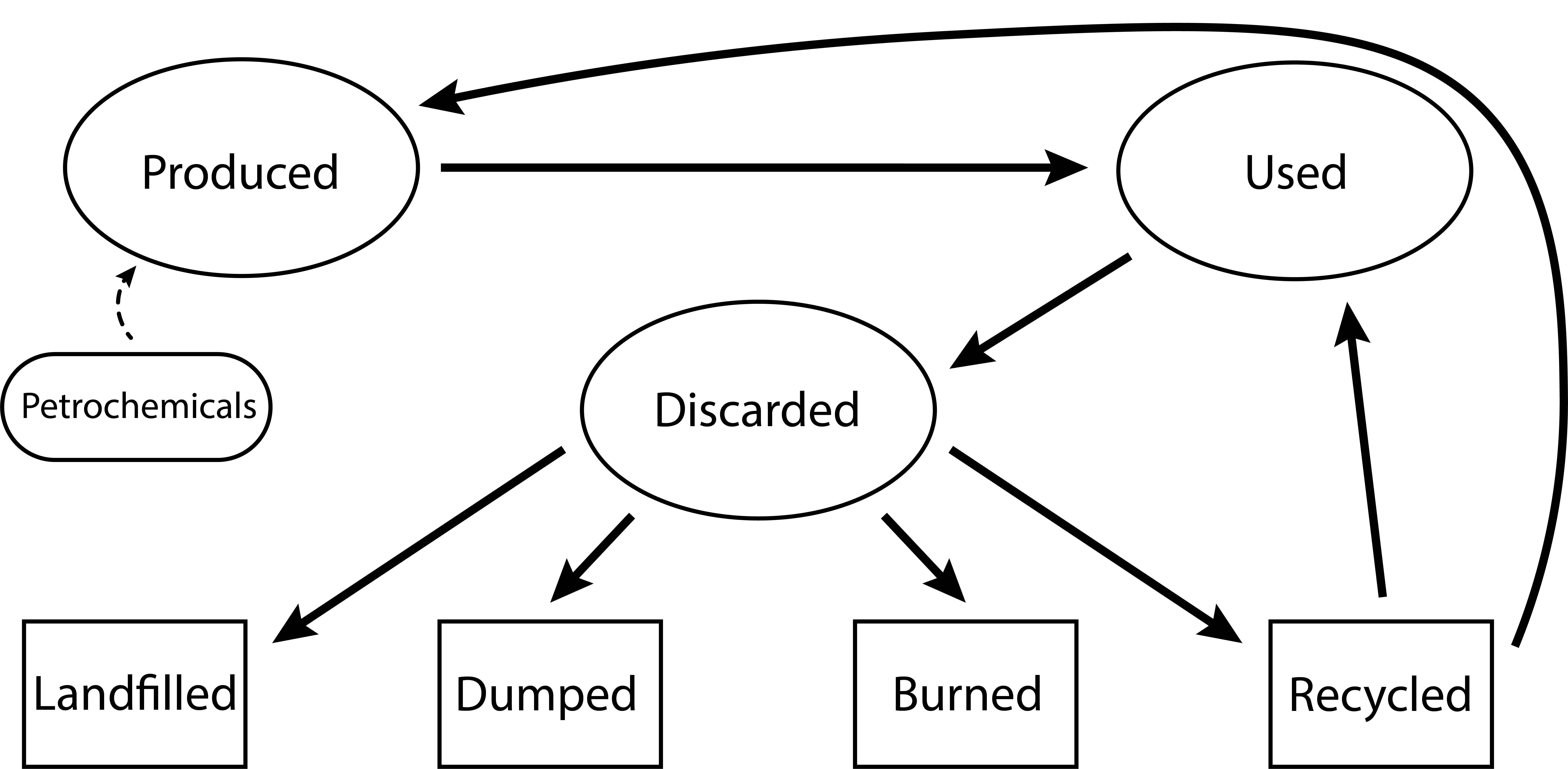
Visual graphic depicting the life cycle of plastics.
Where does plastic come from?
Historically, the raw material for most plastic has been primarily a low-density component of crude oil made up of several categories of relatively small hydrocarbons (molecules containing hydrogen and carbon), including paraffins, naphthalenes, and aromatics. These molecules can, however, also come from other sources, including natural gas (methane, ethane, propane), coal, biomass, and recycled plastic.
Crude oils from different sources vary in their chemistry (for example, in the total amount and/or ratios of paraffins, naphthalenes, and aromatics). The chemical make-up of the different kinds of hydrocarbons influences what kinds of plastics can be produced from them. To make plastic from hydrocarbons, the molecules must be broken ("cracked") into smaller molecules (monomers). These monomers can then be put back together into larger chained polymers to form different kinds of plastics.
Once plastic is made, it is cooled, extruded into "strings," and the strings are cut into pellets (also called "nurdles") a few millimeters in diameter. The pellets are then transported to factories where they are remelted and made into products. Each phase of the process – petroleum extraction, distillation, cracking, polymerization, and production and transport of plastic pellets – requires energy, most of which produces carbon dioxide emissions and also involved some combination of land use, pollution, risks of chemical spills, and waste products. Pellets, for example, are frequently spilled during transport and so are a major component of plastic waste, especially in the oceans.
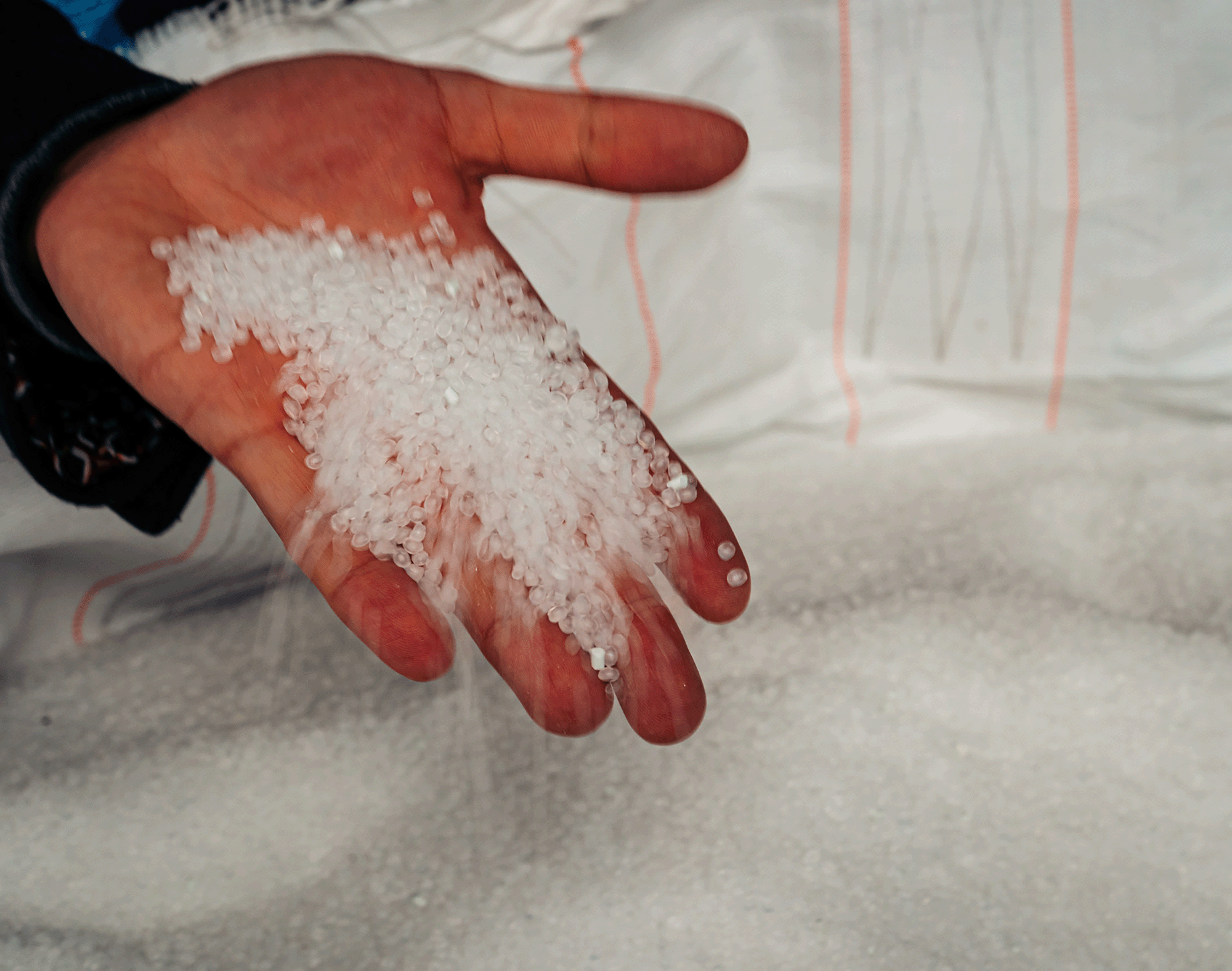
Raw plastic pellets ready for remelting and construction into new products. Image by Adam Cohn (Flickr; Creative Commons Attribution-NC-NoDerivs 2.0 Generic license).
How much plastic is there?
Plastic production is manufacturing, or making plastic from raw materials. Plastic use is how much plastic is purchased. Plastic waste is how much is thrown away (discarded) after it is used. These terms are not always used the same way and can be easily confused. Further confusion comes from the sources of discarded plastic – for example, large-scale commercial vs. municipal (which usually includes small-scale commercial and household). Reporting requirements also vary widely across the U.S. and around the world, making it frequently very difficult to gather reliable data.
Estimates of annual global plastic production today range from around 200 to more than 400 million tons. This has been expressed as roughly equal to the weight of more than 1,000 Empire State Buildings every year. It has been estimated that more than 9 billion tons of plastic has been produced since 1950.
Larger, more populous countries tend to use (and throw away) more plastic overall, but when the data are analyzed per person, the ranking changes significantly. China produces the most plastic of any nation, while the U.S. uses the most. Micronesia throws away the most per capita.
The U.S. produces enough plastic every year for the average American to use about 350 pounds annually. Plastic may be used for a few moments (such as a food wrapper, drink cup, or shopping bag; these are called single-use) or for many years (such as a piece of clothing, car bumper, or construction material). About 50% of the plastic produced each year is single-use. One estimate suggests that around 75% of the plastic produced globally each year reaches the end of its useful lifetime and is discarded; then it is called plastic waste. The average American probably throws away about 270 pounds of plastic waste each year, or about 22.5 pounds each month.
Where does plastic go after it is used?
There are currently four major ways of disposing of plastic waste. When it is discarded, plastic can end up in landfills, or it can be burned (incinerated), recycled, or simply dumped, on land or in water bodies, from which it frequently makes its way to the ocean. (Dumped plastic is sometimes referred to as "mismanaged".)
Annual plastic waste is disposed in four main ways: it is landfilled (blue), dumped (red), burned (green), or recycled (orange). Graph from Our World in Data (Creative Commons Attribution 4.0 International license).
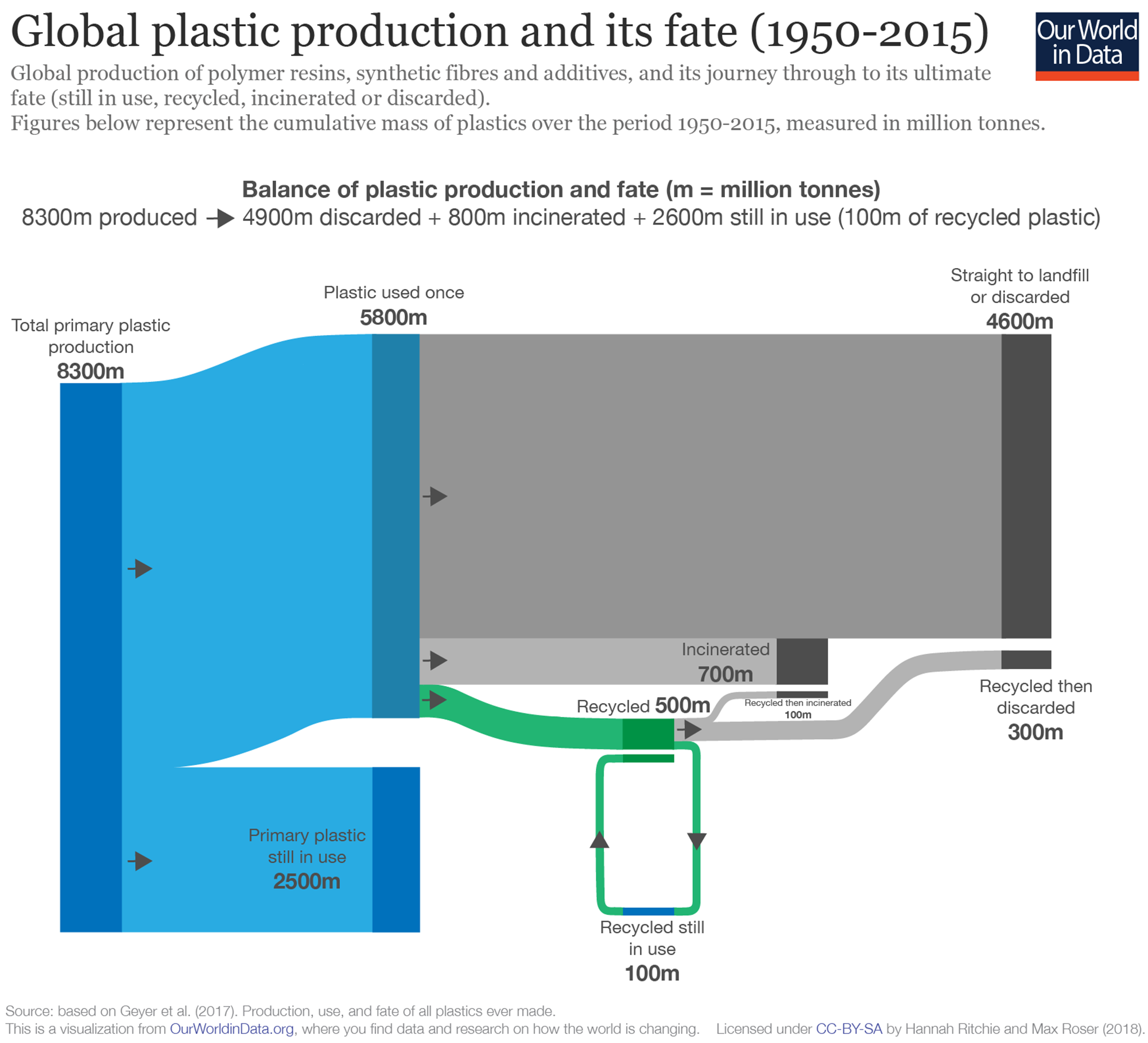
Graph from Our World in Data (Creative Commons Attribution 4.0 International license).
Production, use, and disposal of plastics differ greatly around the world. While many high-income countries generate high amounts of plastic waste per person, they are also typically better at processing it more safely, whereas lower-income countries that are still developing their infrastructure tend to produce and use a higher percentage of mismanaged waste plastic.
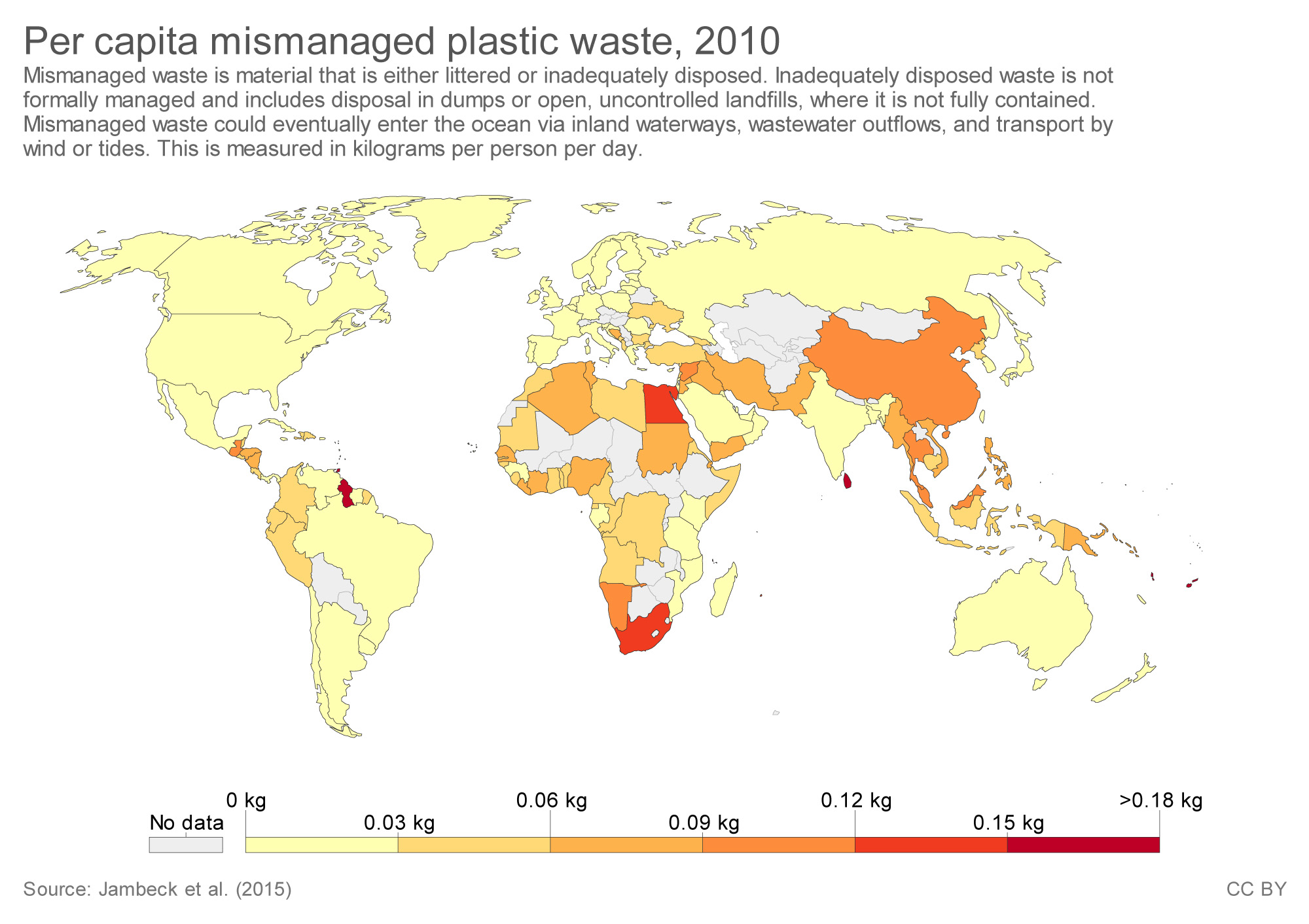
Amount of plastic that is dumped/mismanaged per person in countries across the globe. Graph by Our World in Data (Wikimedia Commons; Creative Commons Attribution 3.0 Unported license).
Burning
A recent estimate indicates that about 13% of all the plastic ever discarded was burned. In 2014, incineration of non-fiber plastic peaked at 21% in 1995 before decreasing to 16% in 2014. The U.S. thus currently burns about twice as much plastic as it recycles.
It turns out to be very difficult to quantify how much plastic is put in formal landfills and how much is dumped into the environment. It has been estimated that between 44 and 57% of all the plastic produced annually around the world (perhaps 100-200 million tons) enters landfills or is dumped, an amount sufficient for rebuilding the currently standing Great Wall of China, a span of about 6000 km (about 3700 miles, longer than the distance from Anchorage, Alaska to New York City), every 12 months. In the U.S., relatively little discarded plastic is intentionally dumped, whereas in some developing countries nearly all is dumped, because there are no landfills or they are not well-managed. About 75% of discarded plastic in the U.S. is landfilled. Plastic that makes it to landfills is not entirely environmentally "safe", however, because – although modern landfills are designed to minimize leakage – if something goes wrong, buried plastic can leach toxic chemicals into ground water. Plastic that is dumped – on land or in water – frequently ends up in the bodies of living things, from birds to people.
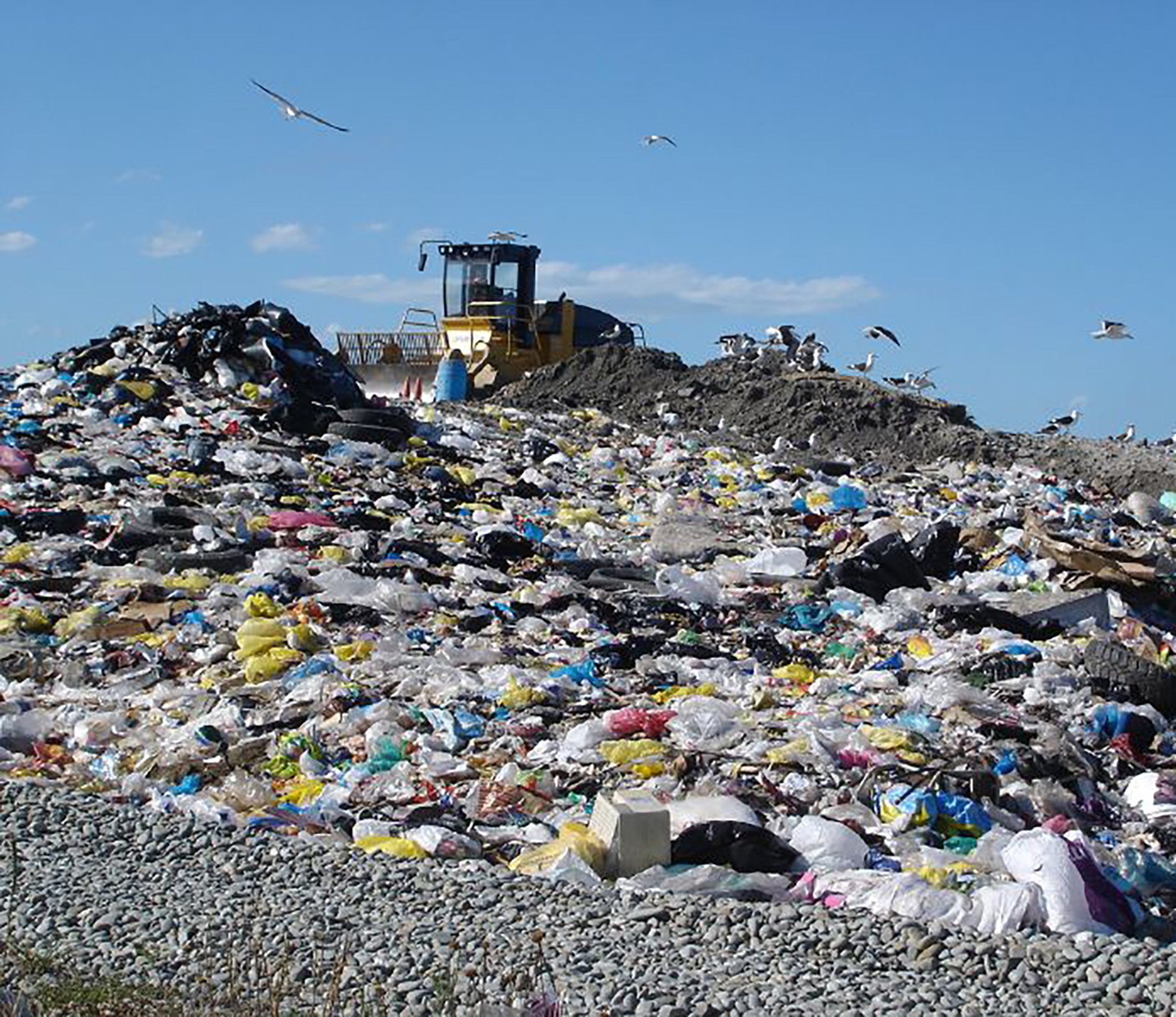
Plastic bags and other plastic discards in a landfill in Timaru, New Zealand. Photo by Samuel Mann (Flickr; Creative Commons Attribution 2.0 Generic license).
Recycling
About 8-9% of the world's discarded plastic is recycled each year, but this varies significantly by country and kind of plastic. In 2014, for example, about 18% of non-fiber plastic was recycled globally, but that ranged from 30% in Europe and 25% in China to about 9% in the U.S. About 10% of all plastic ever recycled was recycled more than once.
How long does plastic last?
Some of the properties that make plastic useful – including stability, durability, biological inertness, and impermeability – mean that it may last a long time after it is discarded. All plastic does "break down" or "degrade" eventually, but this occurs in several ways, all of which can vary significantly depending on environmental conditions. Plastic degradation can include physical breakage and fragmentation as well as chemical alteration into smaller molecules or even eventually into very simple compounds.
Plastic hasn't been around long enough for us to know exactly how long it takes for these processes to occur, so estimates are based on laboratory experiments and extrapolations. Unfortunately, we still don't know enough about these processes.
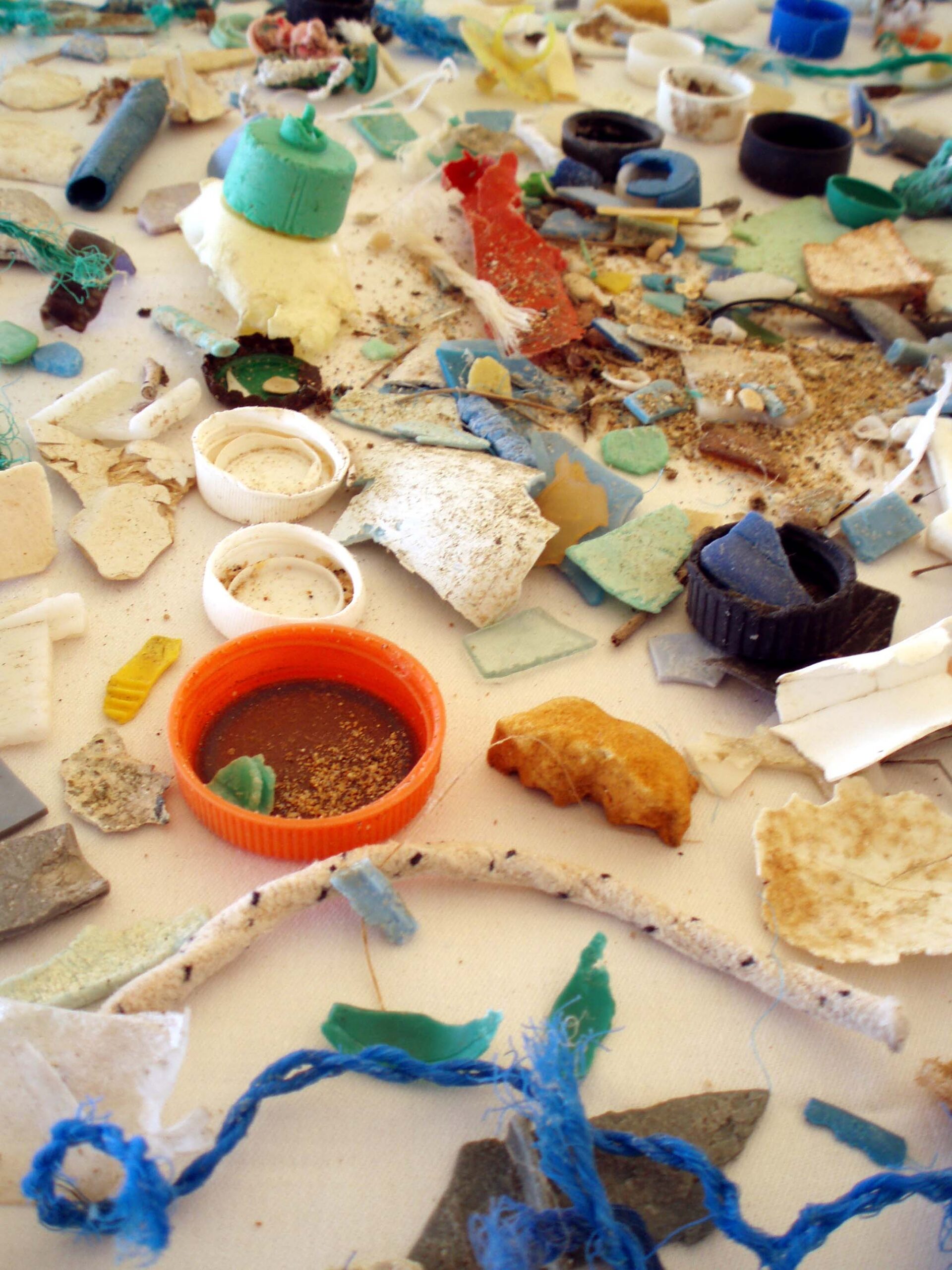
Collection of small, broken down bits of plastic as a result of photodegradation. Image by the NOAA Marine Debris Program (Flickr; Creative Commons Attribution 2.0 Generic license).
Whether a piece of plastic degrades can depend on not just its composition (what kinds of plastic it is), but also its size and shape. It can also depend on the levels of light, oxygen, humidity, and temperature. Many kinds of plastic, for example, break down physically into smaller pieces (including eventually microplastic; see below) in the presence of UV radiation ("photodegradation"), which can make them more likely to degrade chemically. This means that some plastic breaks down more slowly in landfills, where there is no light. Some kinds of plastic break down more rapidly in higher than in lower temperature. In the ocean, degradation can also depend on whether the plastic sinks or floats, which can in turn depend on many factors, including whether it is home to hitchhiking marine organisms.
Thus, rates of plastic degradation frequently mentioned in the media, such as plastic bags or styrofoam cups taking 500 or 1000 years or longer to break down, can be misleading; the truth may be much shorter or longer, and depend on many factors.
One recent detailed review of the scientific literature on this complex topic estimates "half-lives" for plastic degradation (the time it takes for half of the mass of a piece of plastic to be removed) ranging from 58 years for a bottle made of PET (polyethylene terephthalate) to 1200 years for a pipe made of PVC (polyvinyl chloride). Much more research on these topics is clearly needed.
Plastic in the Ocean
Because rivers drain the land and most rivers eventually flow into the ocean, the ocean is the ultimate recipient of much of the world's plastic waste. And this has become an enormous environmental problem. It is estimated that between 1 million and 14 million metric tons (i.e., between about 2.2 million and 31 million pounds) of plastic enters the Earth's oceans each year. At this rate, some researchers suggest that by 2050 there could be more plastic than fish in the oceans by weight.
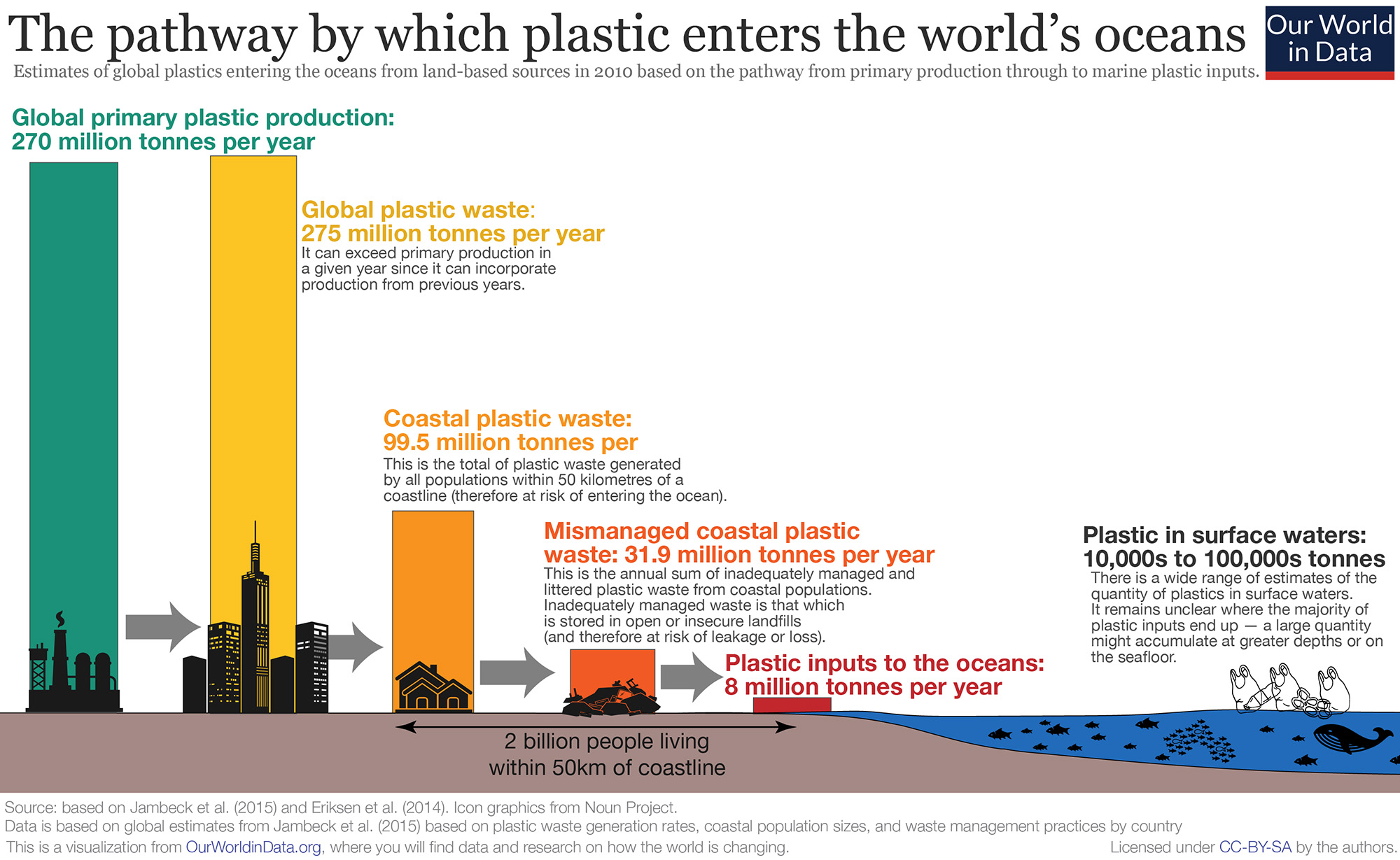
Depiction of the pathway plastics take before ending up in the Earth's oceans. Graphic by Our World in Data (Wikimedia Commons; Creative Commons Attribution ShareAlike 4.0 International license).
A 2014 estimate found that there were approximately 86 million tons of plastic in the world's oceans, equivalent to 1.4% of all plastic produced from 1950 to 2013. Another study indicates that this marine plastic includes more than 5 trillion individual plastic pieces with more than 250,000 tons floating at any one time.
Large scale concentrated accumulations of plastics have been found in the South Pacific subtropical gyre and the Eastern Pacific Ocean gyre. For example, the Great Pacific Garbage Patch is an expanse in the North Pacific Ocean more than twice the size of Texas where discarded plastic accumulates because of converging currents.
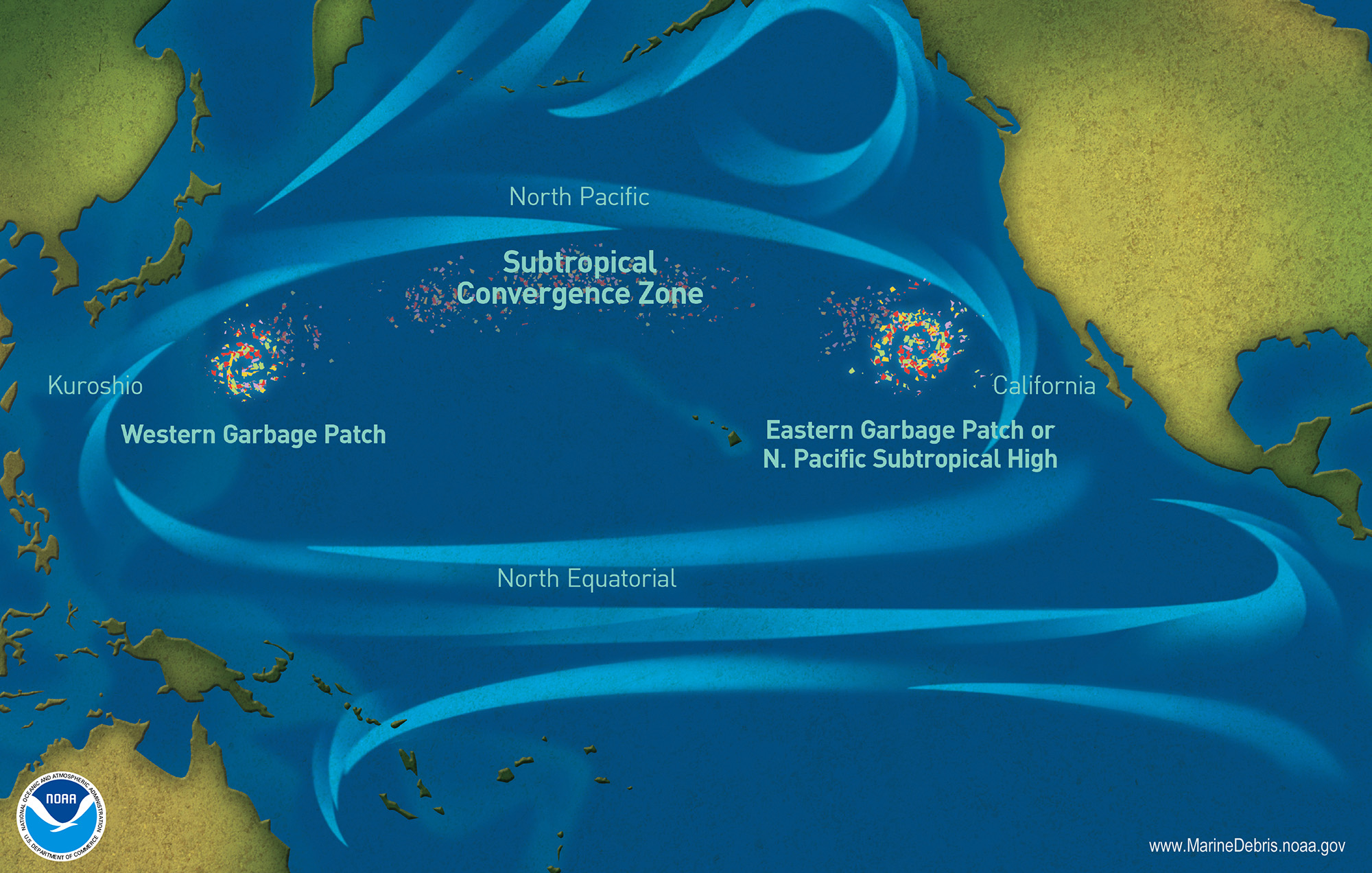
Map showing the location of the Great Pacific Garbage Patch, where accumulations of discarded plastic convalesce at meeting places of converging currents in the North Pacific Ocean gyre. Image by NOAA (Wikimedia Commons; Public domain).
Different types of plastic waste dominate in different parts of the ocean. "Take-out" consumer items (mainly plastic bags and wrappers, food containers and cutlery, and plastic and glass bottles) make up the largest share in nearshore environments, but ocean-based activities such as fishing are the main source for plastic in the open ocean. Taken together, the top ten products, in descending order, were bags (14% across environments), plastic bottles (12%), food containers and cutlery (9%), wrappers (9%), synthetic ropes (8%), fishing-related items (for example, strings, threads, buoys; 8%), plastic caps and lids (6%), industrial packaging (3%), and glass bottles (3%).
It has been estimated that nearly 90% of the plastic entering the ocean comes from just 10 rivers, all located in Asia or Africa. In other words, much of the plastic going into the ocean every year comes from countries with poor or non-existent waste management infrastructure (such as landfills and transport systems), even though it may have been manufactured in countries that have such infrastructure.
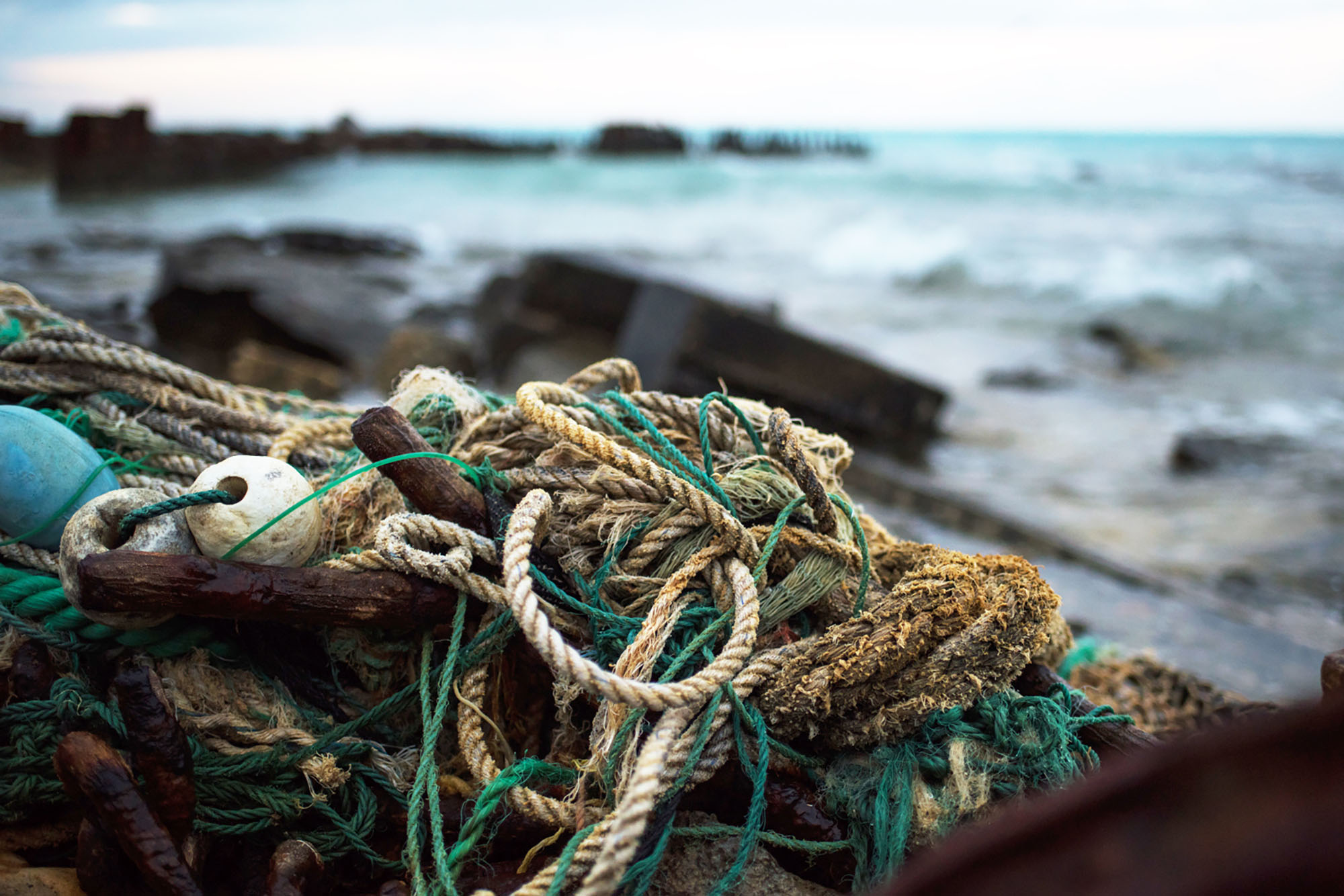
Derelict fishing nets in the Hawaiian Archipelago. Photo by NOAA Coral Reef Ecosystem Program (Flickr; Creative Commons Attribution 2.0 Generic license).
Lost or discarded fishing gear – including nets, lines, and buoys – is a major source of plastic waste in the oceans. Millions of marine animals are unintentionally killed every year by these plastics that strangle, drown, or lacerate them. For example, North Atlantic right whales off New England are frequently tangled in plastic line from lobster traps or fishing nets. PRI's right whale #2030, whose skeleton is displayed in the Museum of the Earth, died for exactly this reason in 2000.
Plastic waste in the ocean is the source of a new kind of rock that is increasingly found on beaches in many parts of the world. This rock – called "plastic rock" or "plastistone" – is a combination of discarded plastic and sediment (sand or gravel), that forms as the plastic degrades and changes as it floats in the water. It has now been found on the shores of five continents.
Efforts to remove plastic from the ocean vary from small-scale beach cleanups to large-scale projects.
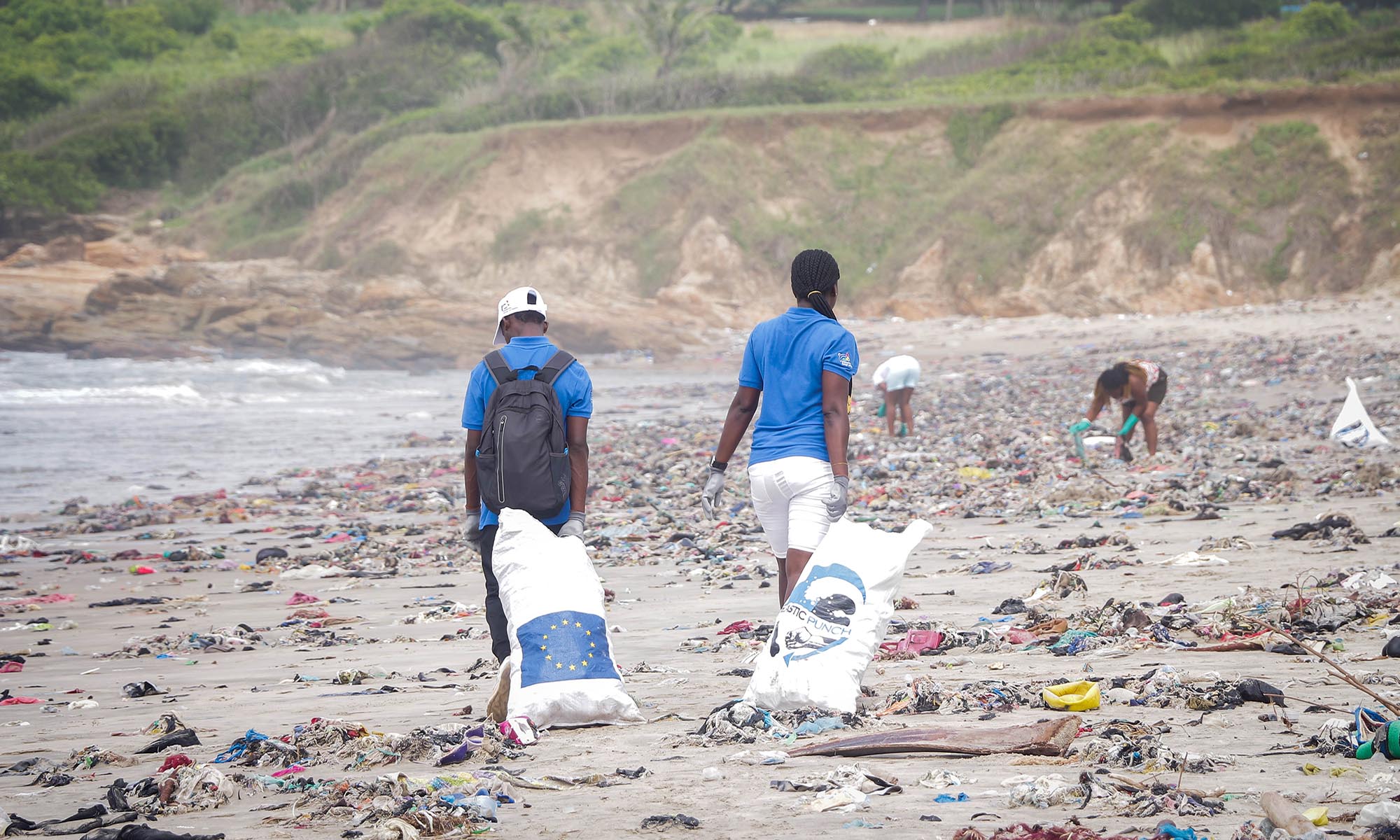
Workers clean up plastic waste from a polluted beach in Ghana. Photo by "Fquasie" (Wikimedia Commons; Creative Commons Attribution-ShareAlike 4.0 International license).
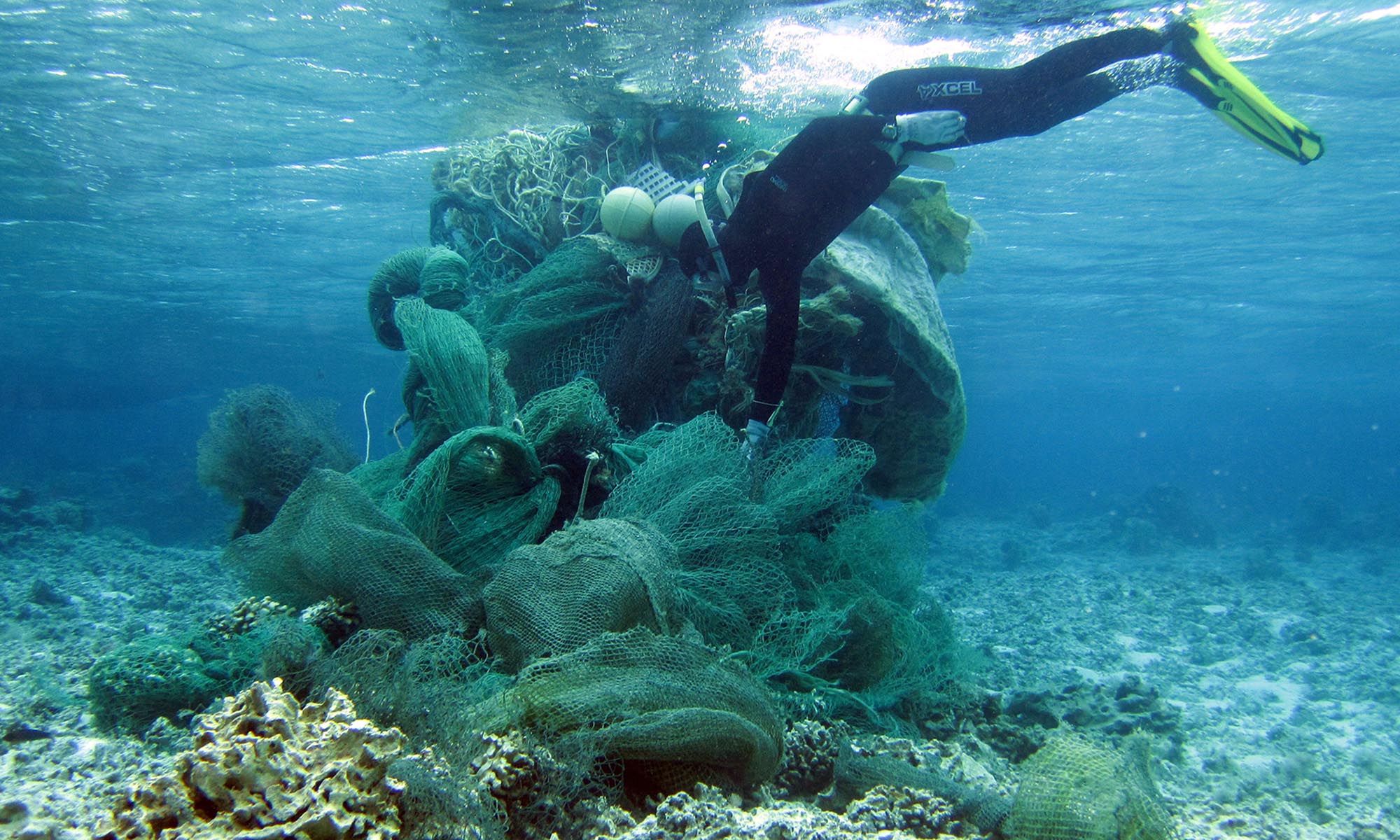
Diver in the NOAA Marine Debris Program cleans up derelict fishing gear in the coastal waters of the northern Hawaiian Islands. Photo by NOAA (Flickr; Creative Commons Attribution-NonCommercial 2.0 Generic license).
The negative impact of plastic on marine life is severe and growing. Hundreds of marine species have been observed to interact directly with plastic debris through ingestion, entanglement, and/or smothering. Many marine animals, from whales to birds, have been found with large amounts of plastic in their digestive systems. More than a third of dead leatherback turtles – the world's largest species of turtle – have ingested plastic. The polyethylene rope used for fishing and lobstering gear is a major source of entanglement for marine animals.
Microplastics
Microplastics, defined as tiny pieces of plastic with the longest dimension being less than 5 millimeters (0.2 inches), have become ubiquitous in Earth's environments; they are almost literally everywhere, from the top of Mount Everest to the deepest part of the oceans, from the Finger Lakes to waters around Antarctica.
Microplastics, in turn, can break down into even smaller pieces called nanoplastics, which are less than 1 μm in size, so small that you cannot see them with the naked eye. The small size of nanoplastics makes them especially difficult to detect and study.
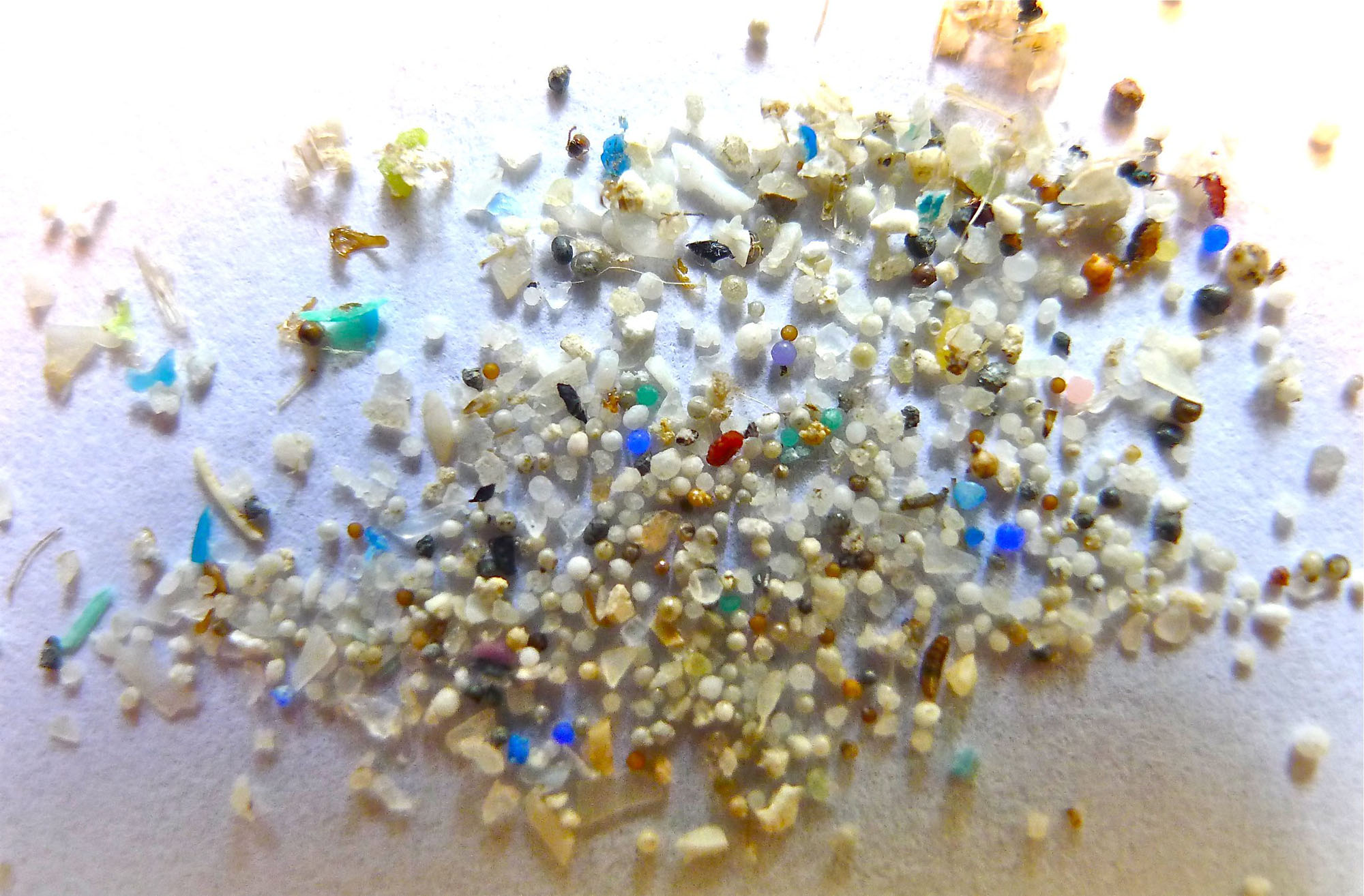
Examples of microplastic particles. Photo by Oregon State University (Flickr; Creative Commons Attribution-ShareAlike 2.0 Generic license).
Micro- and nanoplastics have been found in numerous species of wildlife, from fish to birds to insects. They occur in many human drinking water sources: a recent study of three popular brands of bottled water found that, on average, a liter of bottled water included about 240,000 tiny pieces of plastic, 90% of which were nanoplastics. They have been found throughout human bodies including blood, lungs, brain, placenta, and other organs. Although little is known definitively about their health effects, microplastics are suspected of causing numerous human health problems, including those of the respiratory, endocrine, cardio-vascular, and digestive systems.
Microplastics form by the physical breakdown of larger pieces of plastic, either by physical damage or by photodegradation in sunlight. Dumped plastic, which is exposed to daylight for extended periods, is an important source of microplastic (by photodegradation).

Microplastic fibers from Seneca Lake, NY, May 2021. Photo by Nan Crystal Arens.
Another important and growing source is clothing fibers, including polyester, nylon, acrylic, and polypropylene. Such fibers make up approximately 14% of global plastic production. Global consumption of these synthetic fibers has increased greatly in recent years, and now accounts for at least 55% of the world's clothing market. Microfibers are released from clothing mainly by laundering (both washing and drying). Washing releases microfibers into wastewater, while drying releases them into the air. Wastewater treatment plants can remove up to 99% of microfibers, which are then retained in biosolids ("sludge"). These biosolids, however, are commonly used as additives to soil (although this is not currently the case in many areas, including in Tompkins County), which allows the microplastics to move into the environment where they may last for years.
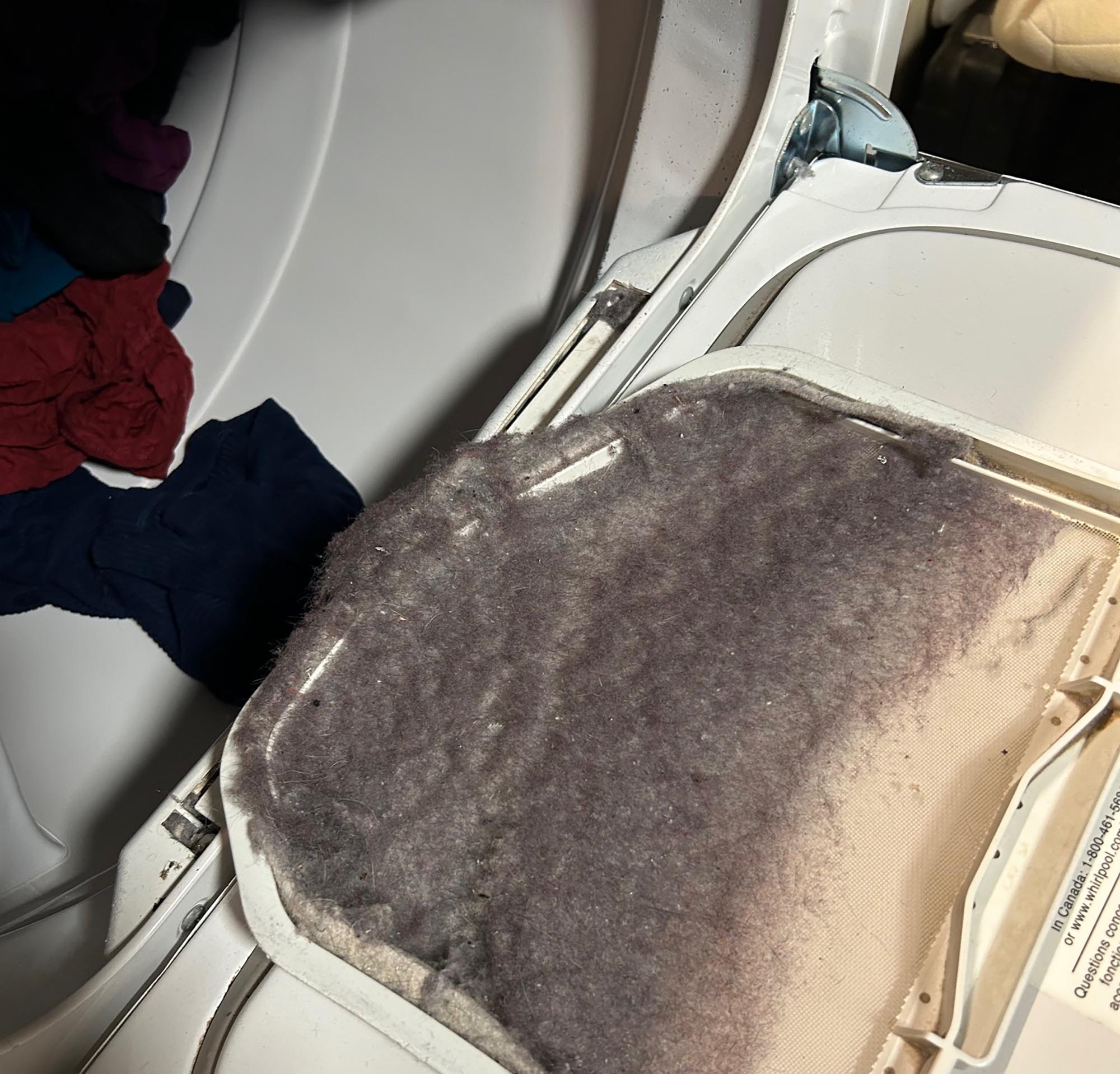
Dryer lint with synthetic microplastic fibers. Photo by Warren Allmon.
Single-Use Plastic Bags
One of the most visible and abundant kinds of single-use plastic is the disposable plastic shopping bag. These bags are commonly made from low-density polyethylene (LDPE). The world uses about 5 trillion plastic bags every year, but this varies dramatically by country: Americans use an average of 365 plastic bags per person per year, while people in Denmark use an average of only four. It has been estimated that globally, less than 1% of them are recycled. The rest are discarded and wind up in either landfills or the environment.
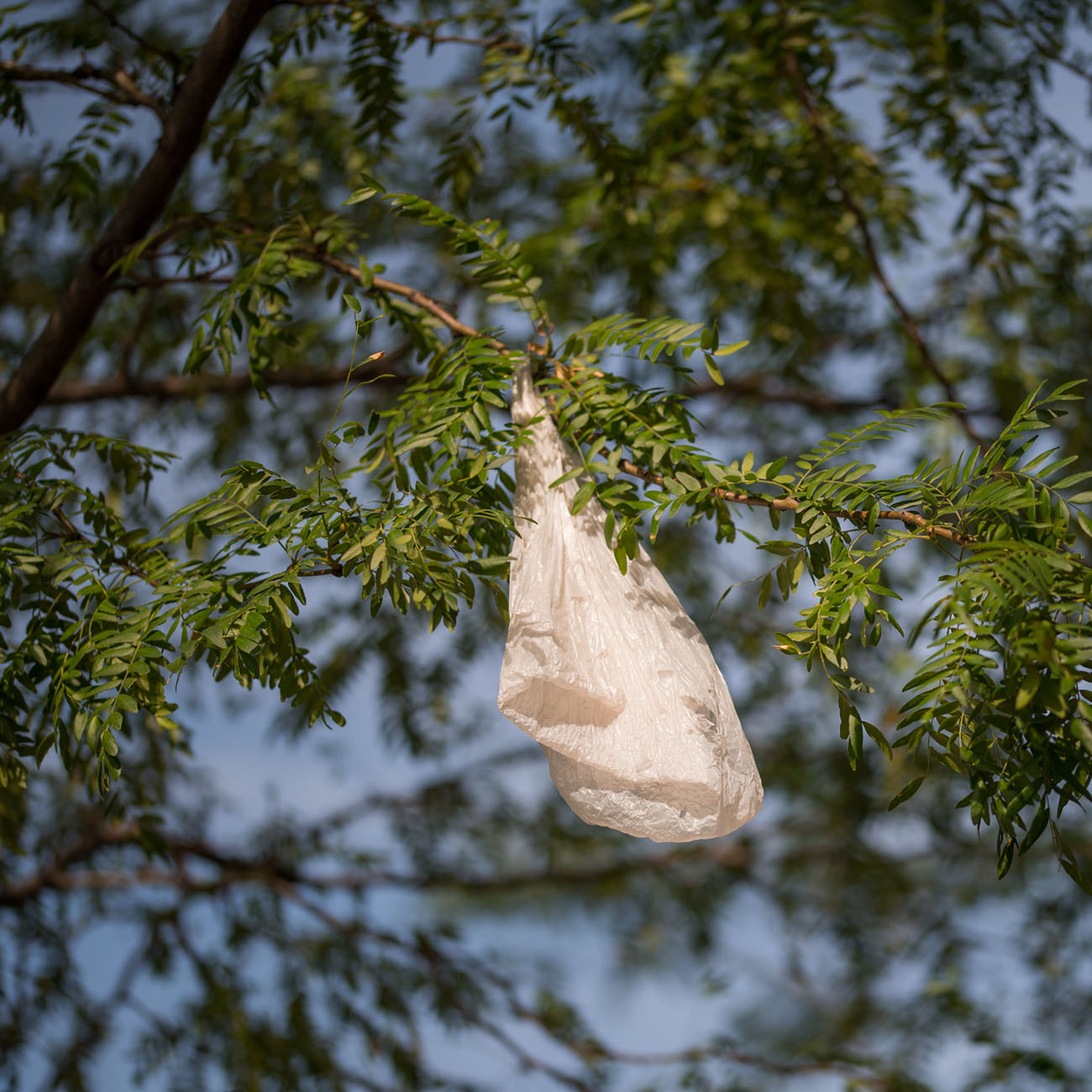
Photo by Ivan Radic (Flickr; Creative Commons Attribution 2.0 Generic license).
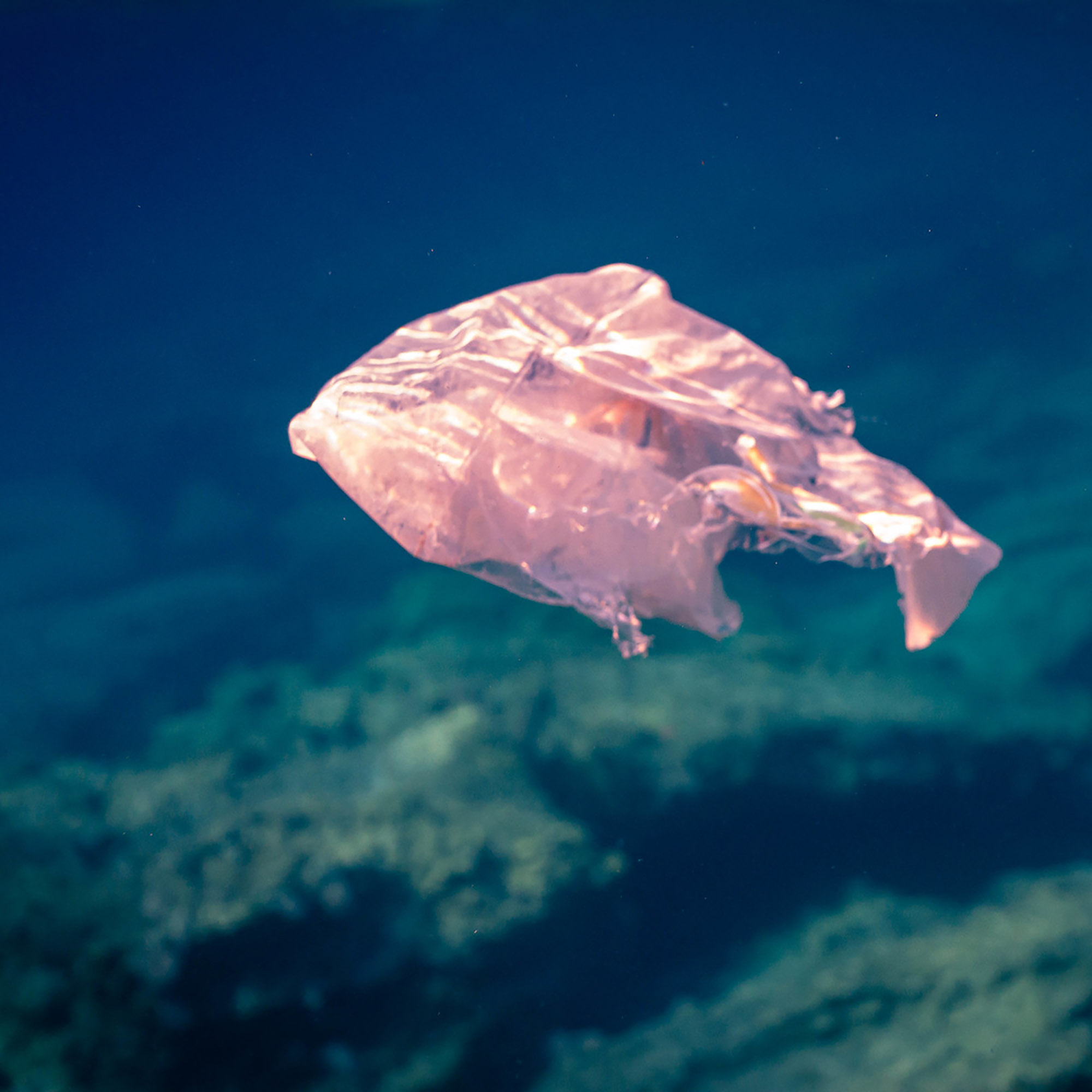
Photo by Paolo Gamba (Flickr; Creative Commons Attribution 2.0 Generic license).
In 2014, California became the first U.S. state to ban plastic shopping bags. As of 2024, the states of California, Colorado, Connecticut, Delaware, Hawaii, Maine, New Jersey, New York, Oregon, Rhode Island, Vermont, and Washington, and the territories of American Samoa, Guam, Northern Mariana Islands, U.S. Virgin Islands, and Puerto Rico have banned disposable bags. Over 200 U.S. counties and municipalities have enacted ordinances either imposing a fee on plastic bags or banning them outright.
Bangladesh became the first country to ban disposable plastic bags in 2002. As of 2022, such bans have been introduced in 99 countries, and 32 countries instead impose a charge per bag.
What about recycling?
Only about 8-9% of the world's discarded plastic is recycled each year, but this varies significantly by country and kind of plastic. A lot of "recycled" plastic winds up in landfills or is simply dumped.
There are many obstacles to increasing recycling:
- A lot of plastic produced today is simply not recyclable, or only partially recyclable, or is too expensive to recycle. Sometimes plastic is not recyclable because of additives, such as colors or chemicals that make it more rigid or more flexible. Products that are composites of multiple kinds of plastic are also usually not recyclable.
- Collected recyclable plastic is often contaminated with other kinds of plastic, and so is rejected from recycling streams and ends up landfilled or dumped.
- There are not enough uses for recycled plastic, and it is usually more expensive to make products from recycled plastic than from "virgin" plastic.
In Tompkins County, NY (where PRI is located), data are not available on exactly how much plastic waste is recycled. About 14% of all municipal waste in the County is plastic, and about 10-20% of all waste is recycled. It is possible that the average Tompkins County resident throws away 1000 pounds of total waste per year (about 3 pounds per day), of which perhaps 150 pounds is plastic. Thus the average Tompkins County resident probably discards about 12.5 pounds of plastic per month.
The Recycling Symbol
The familiar "chasing arrows" with a number in the center, which is stamped onto most plastic products, does not necessarily mean that the product is recyclable; it just identifies what kind of plastic it is.
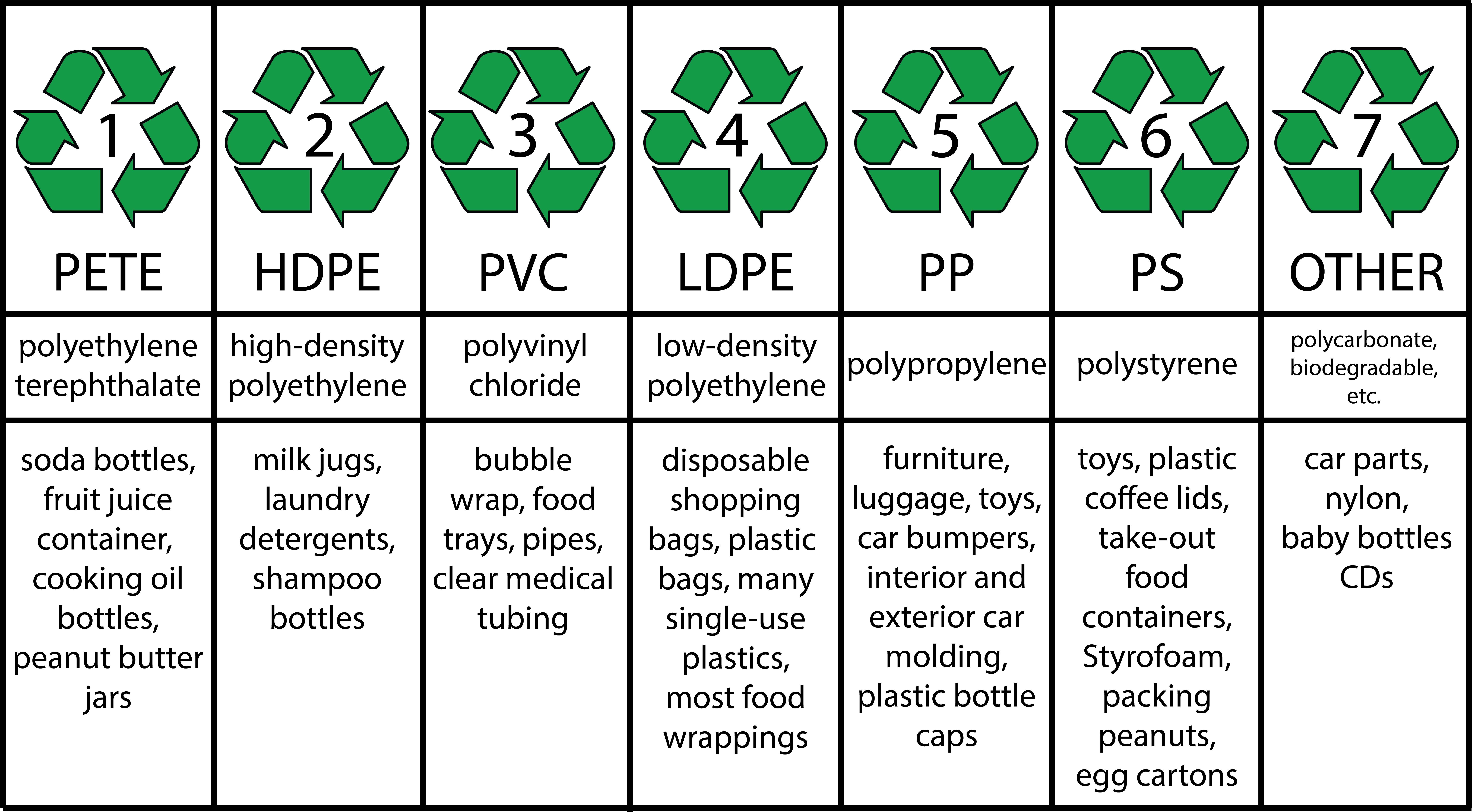
The seven numbers of plastic correspond to certain compositional types. Some common examples of each type are listed.
Most plastics marked "1" or "2" are widely accepted for recycling in the U.S. Depending on where you live, it may also be possible to recycle ones marked "5". Bags are usually recyclable only at stores, but this varies by location (for example, New York State law, for example, requires certain retailers to establish a plastic film recycling program). Most plastics marked "4" or "7" generally aren't recyclable.
In Tompkins County, New York, plastics marked "1", "2", or "5" are accepted by curbside recycling programs. Plastic bags are accepted for recycling at many stores, but not curbside.
Solutions
The world is drowning in plastic waste and major action is urgently needed.
Solutions that would make a major impact include:
More effective waste management infrastructure in all nations. Wealthy nations sell a lot of plastic products, and ship a lot of their plastic waste, to low- or middle-income nations, many of which lack sufficient investment in waste management infrastructure.
Stricter legislation and management of fishing activity and waste. Lost or discarded fishing gear – lines, nets, buoys – are major components of plastic in the ocean. Enforceable rules are needed to prioritize reuse, recycling, and cleanup of this gear.
More and better recycling. More education, encouragement, and requirements for more, and more effective, recycling are needed. This includes simple things like better identification and sorting, and more difficult things like finding new and economical uses for recycled plastics, and also new technologies that make currently unrecyclable plastics recyclable. Some of these technologies are already being developed.
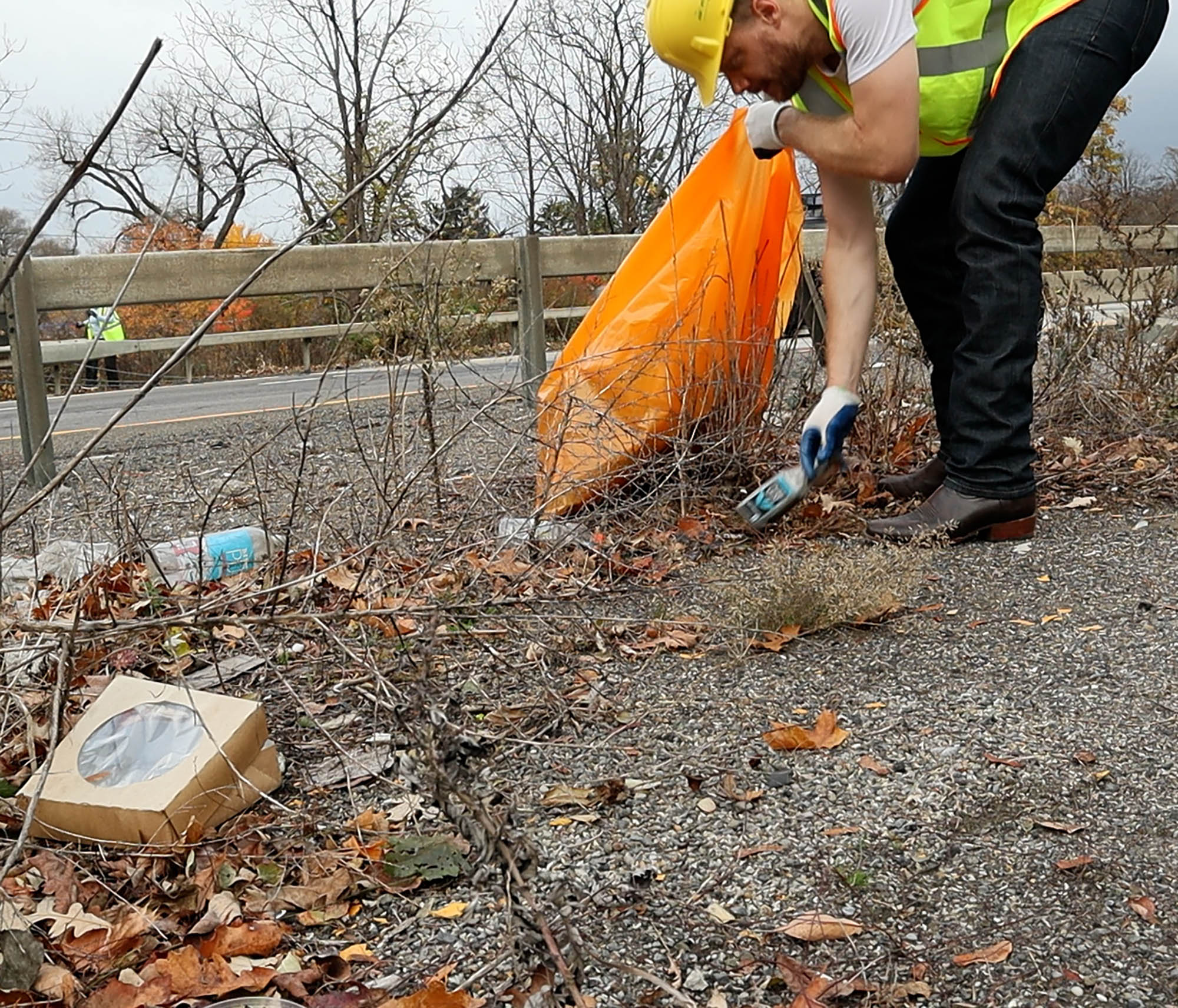
Members of the Rotary Club of Ithaca, New York, picking up discarded plastic from a roadside on Earth Day (April 22) 2024. Photo by Jeremiah Craig.
Alternative sources for plastic. Extremely little of today's mass-produced plastic is biodegradable. New research, however, including making sneaker soles out of plant-based products or reprocessing crab, shrimp, and lobster shells, may be able to increase the amount of plastic that is not made from toxic and non-biodegradable petrochemicals.
Reducing at the source. A number of nations and jurisdictions within the U.S. have passes or are considering laws that put more responsibility for dealing with plastic on the companies that produce it, through fees, recycled content requirements, or other measures. For example, in 2020 France passed legislation requiring producers to take responsibility for the plastic they make, and this is currently being phased in with the goal of a completely circular economy – which extends the life of existing materials as long as possible by sharing, leasing, reusing, repairing, refurbishing, and recycling – by 2040.
What can individuals do?
Reuse and recycle. Reuse plastics for as long as possible, then recycle them instead of discarding them. Pay attention to the types of plastic that are recyclable in your area, and try to avoid contaminating your curbside recycling with non-recyclables or other trash.
Mind your laundry. Washing and drying clothes is a big source of microplastics entering the environment. Individuals can do a lot to minimize the amount of microfiber plastics discarded in washer wastewater or dryer lint.
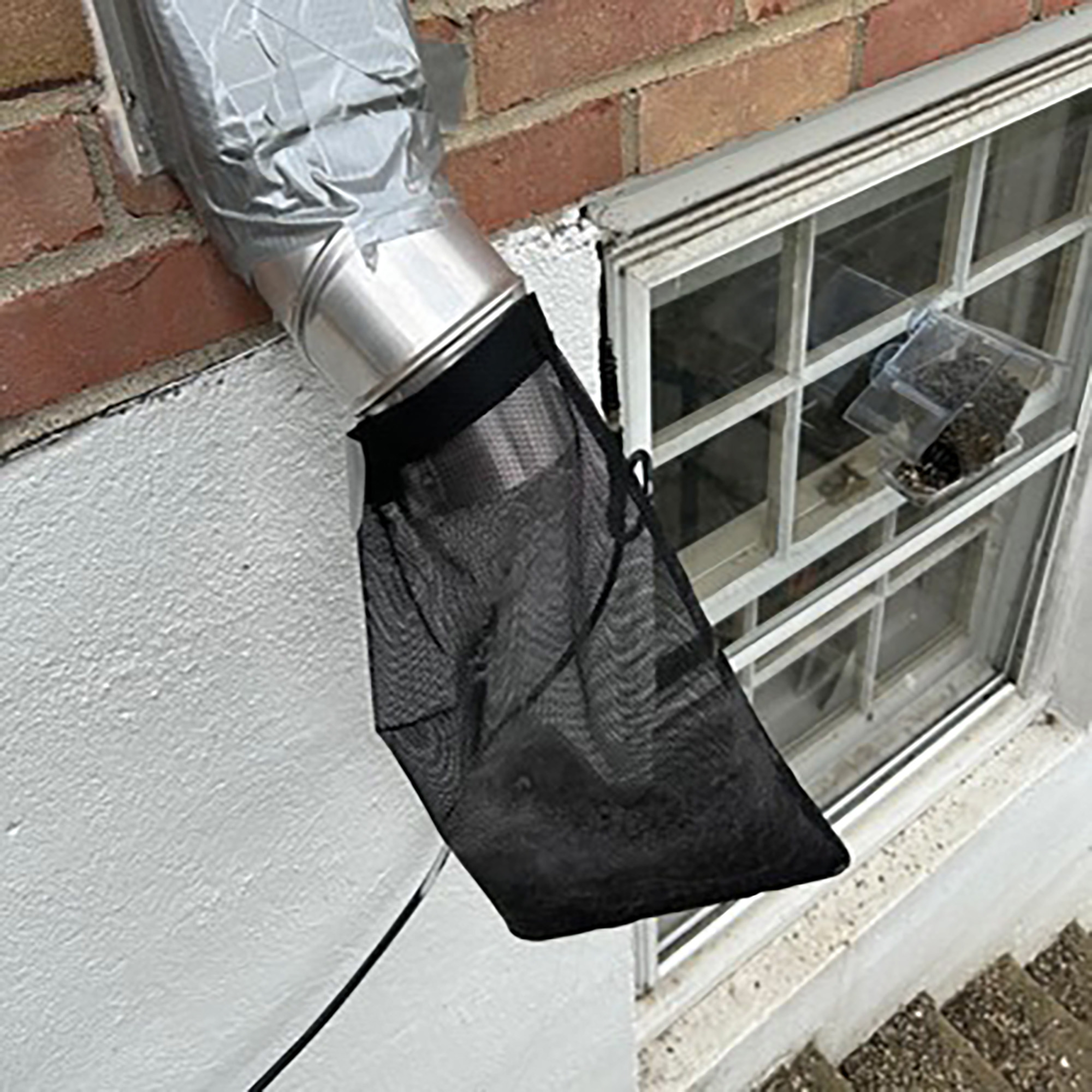
A dryer exhaust bag over the exterior vent can collect plastic fabric fibers before they enter the environment. Photo by Warren Allmon.

Using dryer balls can not only help collect dryer lint, but also increase the efficiency of drying. Photo by Steve Snodgrass (Flickr; Creative Commons Attribution 2.0 Generic license).
Reduce your use. Buy and use less plastic! For example:
- Consider switching to different products or brands (ones with less packaging or more recycled or recyclable packaging). Try not to buy produce wrapped in plastic.
- Make fewer purchases online (plastic mailers and foam packaging aren't accepted by most recycling programs).
- Use reusable cups, bottles, bags, and utensils when you can.
- Patronize merchants that use less plastic.
- Look for alternatives to plastic, or plastic that is biodegradable.
- Don't buy plastic stuff you don't need, at home and at work.
"The same properties that make plastics so versatile in innumerable applications – durability and resistance to degradation – make these materials difficult or impossible for nature to assimilate. Thus, without a well-designed and tailor-made management strategy for end-of-life plastics, humans are conducting a singular uncontrolled experiment on a global scale, in which billions of metric tons of material will accumulate across all major terrestrial and aquatic ecosystems on the planet." (Geyer et al. 2017)
Learn more about reducing your plastic use:
https://www.beyondplastics.org/
https://myplasticfreelife.com/plasticfreeguide/
https://www.nytimes.com/2019/02/16/style/plastic-free-living.html
Wrapped in Plastic video by the Paleontological Research Institution
Additional Resources
US National Oceanic and Atmospheric Administration− Marine Debris program
US National Academy of Sciences report (2022)− "Reckoning with the U.S. role in global ocean plastic waste"
US Environmental Protection Agency− Trash Free Waters program
National Park Service− Ocean Plastics
Pew Charitable Trusts− Preventing Ocean Plastics project
The New York Times− "How can you recycle plastic packaging?"
Acknowledgments
Thanks to Susan Allen (Ithaca College); Alex Allmon and Mark Johnson (Ithaca High School); Nan Crystal Arens (Hobart & William Smith Colleges); Linda Tseng (Colgate University); Chris Alabi, Brian Bauer, Bethany Jorgenson, and Marianne Krasny (Cornell University); Jan Factor (SUNY Purchase); Kat McCarthy (Recycling and Materials Management of Tompkins County); Kiera Crowley, Jon Hendricks, Alex Moore, Rob Ross, and Ingrid Zabel (PRI); and Jennifer Tegan.
References & Further Reading
Bergman, M., L. Gutow, and M. Klages, editors, 2015. Marine anthropogenic litter. Springer International Publishing, Cham, Switzerland, 447 p.
Bhuyan, M.S., 2022. Effects of microplastics on fish and in human health. Frontiers in Environmental Science, 10: p.827289. doi: 10.3389/fenvs.2022.827289
Brynzak-Schreiber, E., Schögl, E., Bapp, C., Cseh, K., Kopatz, V., Jakupec, M.A., Weber, A., Lange, T., Toca-Herrera, J.L., Del Favero, G. and Wadsak, W., 2024. Microplastics role in cell migration and distribution during cancer cell division. Chemosphere, 353: 141463. doi: 10.1016/j.chemosphere.2024.141463
Chamas, A., H. Moon, J. Zheng, Y. Qiu, T. Tabassum, J.H. Jang, M. Abu-Omar, S.L. Scott, and S. Suh, 2020. Degradation rates of plastics in the environment. ACS Sustainable Chem. Eng., 2020(8): 3494−3511. doi: 10.1021/acssuschemeng.9b06635
Cunningham, E.M., S.M. Ehlers, J.T. Dick, J.D. Sigwart, K. Linse, J.J. Dick, and K. Kiriakoulakis, 2020, High abundances of microplastic pollution in deep-sea sediments: evidence from Antarctica and the Southern Ocean. Environmental Science and Technology, 54(21): 13661−13671. https://pubs.acs.org/doi/epdf/10.1021/acs.est.0c03441
Danyang Tao, Kai Zhang, Shaopeng Xu, Huiju Lin, Yuan Liu, Jingliang Kang, Tszewai Yim, J.P. Giesy, and K.M.Y. Leung, 2022, Microfibers released into the air from a household tumble dryer. Environmental Science & Technology Letters, 9(2): 120−126. doi: 10.1021/acs.estlett.1c00911
Gavigan, J., T. Kefela, I. Macadam-Somer, S. Suh, and R. Geyer, 2020, Synthetic microfiber emissions to land rival those to waterbodies and are growing. PLoS ONE 15(9): e0237839. doi: 10.1371/journal.pone.0237839
Eriksen, M., N. Maximenko, M. Thiel, A. Cummins, G. Lattin, S. Wilson, J. Hafner, A. Zellers, and S. Rifman, 2013, Plastic pollution in the South Pacific Subtropical Gyre. Marine Pollution Bulletin, 68(1-2): 71−76. doi: 10.1016/j.marpolbul.2012.12.021
Eriksen, M., L.C. Lebreton, H.S. Carson, M. Thiel, C.J. Moore, C. Borerro, F. Galgani, P.G. Ryan, and J. Reisser, 2014, Plastic pollution in the world's oceans: more than 5 trillion plastic pieces weighing over 250,000 tons afloat at sea. PLoS One, 9(12): e111913. doi: 10.1371/journal.pone.0111913
Fisner, M., S. Taniguchi, F. Moreira, M.C. Bícego, and A. Turra, 2013, Polycyclic aromatic hydrocarbons (PAHs) in plastic pellets: Variability in the concentration and composition at different sediment depths in a sandy beach. Marine Pollution Bulletin, 70 (1), 219−226. doi: 10.1016/j.marpolbul.2013.03.008
Gall, S.C., and R.C. Thompson, 2015, The impact of debris on marine life. Marine Pollution Bulletin, 92(1): 170−179. doi: 10.1016/j.marpolbul.2014.12.041
Galloway, T., and C. Lewis, 2017, Quick guide: Marine microplastics. Current Biology, 27: R431−R510. doi: 10.1016/j.cub.2017.01.043
Geyer, R., J.R. Jambeck, and K.L. Law, 2017, Production, use, and fate of all plastics ever made. Science Advances, 3(7): e1700782. doi: 10.1126/sciadv.170078
Jambeck, J.R., R. Geyer, C. Wilcox, T.R. Siegler, M. Perryman, A. Andrady, R. Narayan, Ramani, and K.L. Law, 2015, Plastic waste inputs from land into the ocean. Science, 347: 768−771. doi: 10.1126/science.1260352
Jang, Y.C., J. Lee, S. Hong, H.W. Choi, W.J. Shim, and S.Y. Hong, 2015, Estimating the global inflow and stock of plastic marine debris using material flow analysis: a preliminary approach. Journal of the Korean Society for Marine Environment & Energy, 18(4): 263−273. doi: 10.7846/JKOSMEE.2015.18.4.263
Jemec, K.A., A. Dolar, J. Titova, M. Visnapuu, L. Škrlep, D. Drobne, H. Vija, V. Kisand, and M. Heinlaan, 2021. Long term exposure to virgin and recycled LDPE microplastics induced minor effects in the freshwater and terrestrial crustaceans Daphnia magna and Porcellio scaber. Polymers, 13(5): 771. doi: 10.3390/polym13050771
Law, K.L., S.E. Moret-Ferguson, D.S. Goodwin, E.R. Zettler, E. DeForce, T. Kukulka, and G. Proskurowski, 2014, Distribution of surface plastic debris in the Eastern Pacific Ocean from an 11-year data set. Environmental Science and Technology, 48(9): 4732−4738. doi: 10.1021/es4053076
Kaiser, J., 2010, The dirt on ocean garbage patches. Science, 328: 1506. doi: 10.1126/science.328.5985.1506
Morales-Caselles, C., J. Viejo, E. Martí, D. González-Fernández, H. Pragnell-Raasch, J.I. González-Gordillo, E. Montero, G.M. Arroyo, G. Hanke, V.S. Salvo, and O.C. Basurko, 2021. An inshore–offshore sorting system revealed from global classification of ocean litter. Nature Sustainability, 4(6): 484−493. doi: 10.1038/s41893-021-00720-8
Mrosovsky, N., 2009. Leatherback turtles: The menace of plastic. Marine Pollution Bulletin, 58: 287−289. doi: 10.1016/j.marpolbul.2008.10.018
Napper, I.E., B.F.R. Davies, H. Clifford, S. Elvin, H.J. Koldewey, P.A. Mayewski, K.R. Miner, M. Potocki, A.C. Elmore, A.P. Gajurel, and R.C. Thompson, 2020, Reaching new heights in plastic pollution— preliminary findings of microplastics on Mount Everest. One Earth 3: 621−630. doi: 10.1016/j.oneear.2020.10.020
Peng, X., Chen, M., Chen, S., Dasgupta, S., Xu, H., Ta, K., Du, M., Li, J., Guo, Z. and Bai, S., 2018. Microplastics contaminate the deepest part of the world’s ocean. Geochemical Perspectives Letters, 9(1): 1−5. doi: 10.7185/geochemlet.1829
Qian, N., X. Gao, X. Lang, H. Deng, T.M. Bratu, Q. Chen, P. Stapleton, B. Yan, and W. Min, 2024. Rapid single-particle chemical imaging of nanoplastics by SRS microscopy. Proceedings of the National Academy of Sciences of the USA. Jan 16;121(3): e2300582121. doi: 10.1073/pnas.2300582121
Rios, L.M., P.R. Jones, C. Moore, and U.V. Narayan, 2010, Quantitation of Persistent Organic Pollutants adsorbed on plastic debris from the Northern Pacific Gyre’s Eastern Garbage Patch. Journal of Environmental Monitoring, 12(12): 2226−2236. doi: 10.1039/c0em00239a
Santos, F.A., G.R. Diório, C.C.F. Guedes, G. Fernandino, P.C. Giannini, R.J. Angulo, M.C. de Souza, M.A.F. César-Oliveira, and A.R. dos Santos Oliveira, 2022, Plastic debris forms: Rock analogues emerging from marine pollution. Marine Pollution Bulletin, 182: 114031. doi: 10.1016/j.marpolbul.2022.114031
Schmidt, C., T. Krauth, and S. Wagner, 2017, Export of plastic debris by rivers into the sea. Environmental Science and Technology, 51(21): 12246−12253. doi: 10.1021/acs.est.7b02368
Tetu, S.G., I. Sarker, V. Schrameyer, R. Pickford, L.D.H. Elbourne, L.R. Moore, and I.T. Paulsen, 2019. Plastic leachates impair growth and oxygen production in Prochlorococcus, the ocean’s most abundant photosynthetic bacteria. Communications Biology, 2: 184. doi: 10.1038/s42003-019-0410-x
US National Academy of Sciences, 2022. Reckoning with the U.S. role in global ocean plastic waste. doi: 10.17226/26132
Wang, L. and D. Hou, D., 2023, Plastistone: An emerging type of sedimentary rock. Earth-Science Reviews, 247: 104620. doi: 10.1016/j.earscirev.2023.104620
Yue Li, Le Tao, Qiong Wang, Fengbang Wang, Gang Li, and Maoyong Song, 2023, Potential health impact of microplastics: A review of environmental distribution, human exposure, and toxic effects. Environment & Health, 1(4): 249−257. doi: 10.1021/envhealth.3c00052
Zlotnick, S., 2023, Even in Antarctica, Krill Are Eating Plastic. Sierra Magazine, June 5. https://www.sierraclub.org/sierra/even-antarctica-krill-are-eating-plastic



